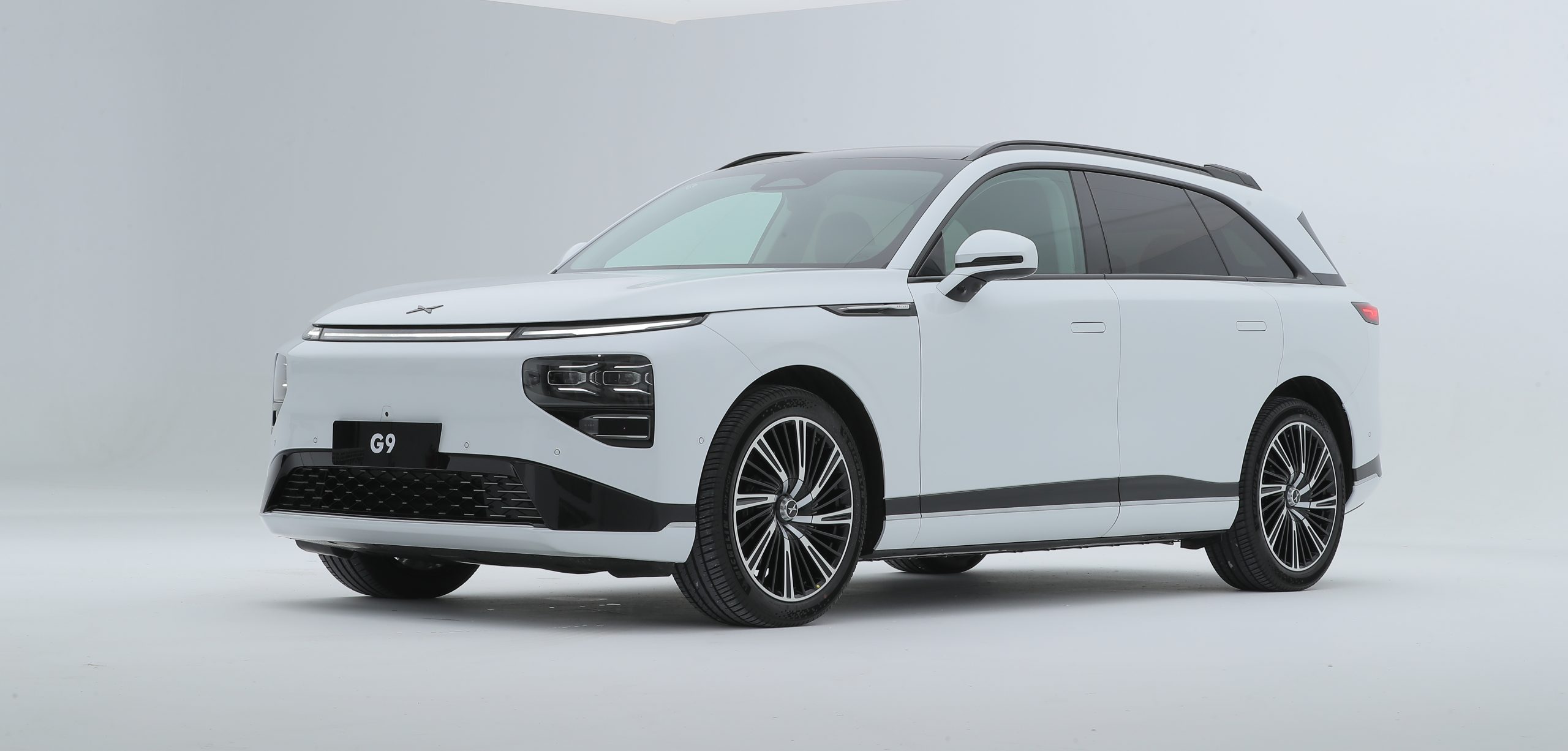From the official debut at the 2021 Guangzhou Auto Show to the release of the interior on the 10th of this month, it took Xpeng’s G9 model a full half year to prepare for its “main course”. However, by August of this year, not only had NIO and Li Auto, two other new forces in the industry, released their latest flagship SUVs, but a new player named Avita 11 also emerged. Recently, Li Auto has even claimed that they will not only release the L9 model, but also the L8 model this year. It seems that for a while, everyone has rushed into the high-end SUV market priced between 300,000 to 500,000 yuan.
So, what does Xpeng’s G9 have to offer that would allow it to stand out in this “red ocean” of high-end new energy SUVs? Let’s take a closer look and find out.
Exterior Design
The exterior of the G9 is certainly familiar to many, having been on display at the Guangzhou Auto Show many times. At first glance, when I saw the actual car, I didn’t feel particularly surprised, and even thought it looked a bit like a larger G3i.
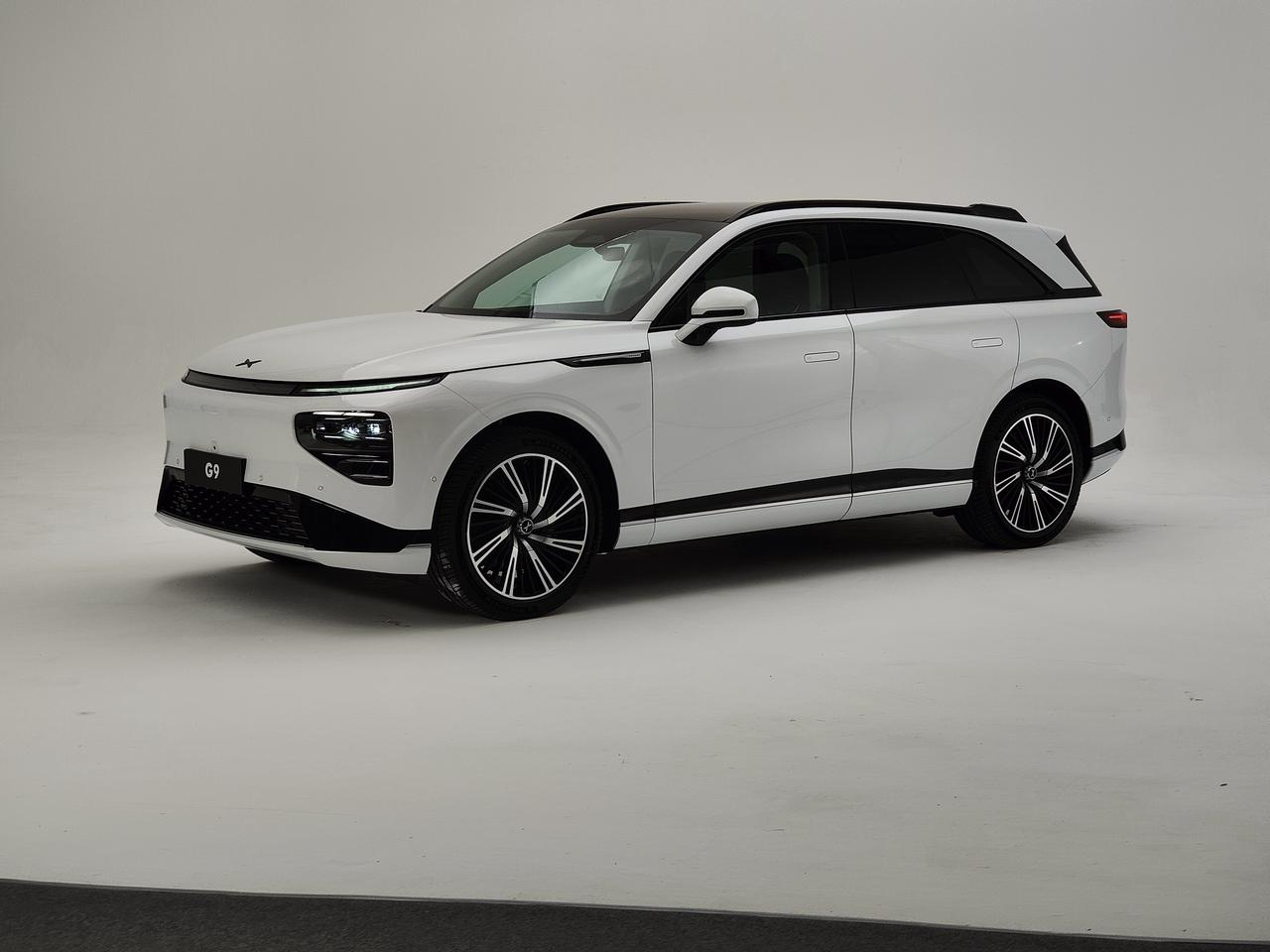
But as I observed the car more closely, I discovered many details that are not well-known.
Unique details in a family-style design
Let’s start with the front of the car. At first glance, the headlights look very similar to those on the G3i. However, Xpeng has added 4 light bars to the upper and lower positions of the headlights, which they call the “X-BOT FACE Peng Wing Light”. When all 4 light bars are on, they look really nice up close.
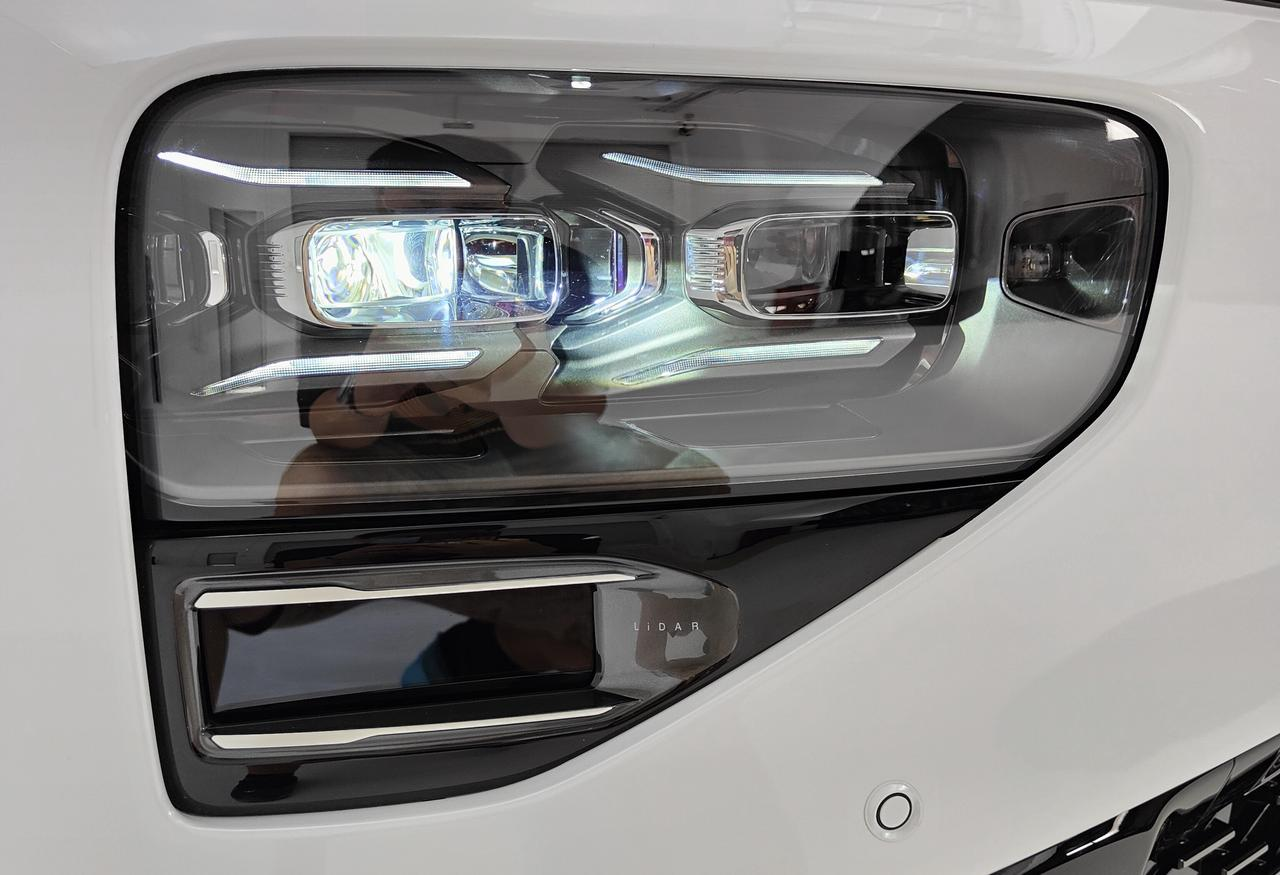
Below the headlights are the two LIDAR sensors for the G9, which are located in almost the exact same position as the P5. However, the difference is that the P5’s LIDAR sensor protrudes from the entire front of the car, which means that there is a high probability of damage if the car is scratched or hit on the left or right side. The G9 has cleverly integrated the LIDAR sensors into the curve of the entire front of the car, reducing the risk of damage.
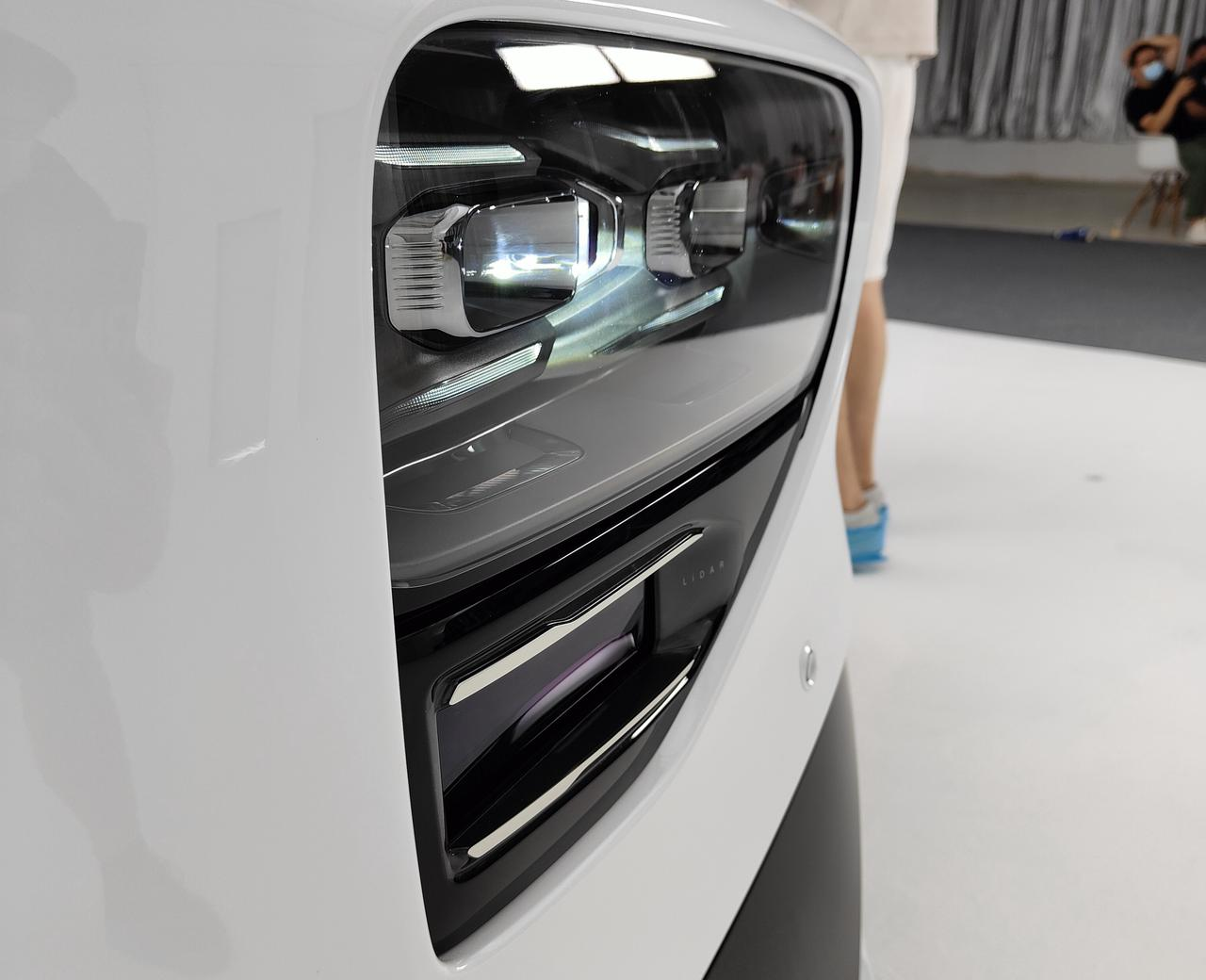
At the end of the engine hood on both sides, G9 has added two black decorative panels, each with a silver decoration, which distinguishes it from the all-black design of the P7. Meanwhile, the rear-facing camera is also placed in this location.
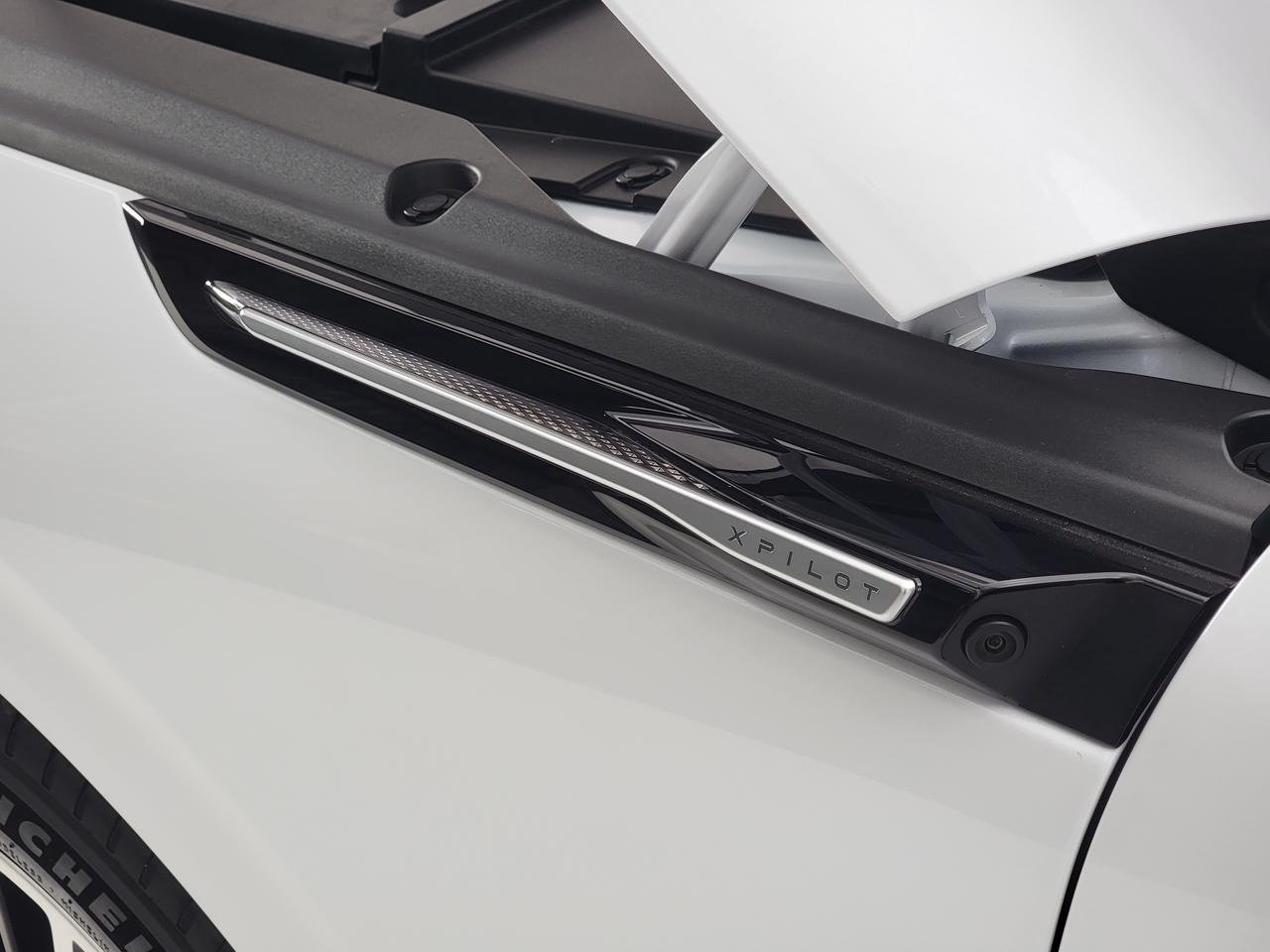
The demonstration car uses 21-inch multi-spoke wheels instead of the petal-shaped low-drag wheels seen before. According to the registration information released by the Ministry of Industry and Information Technology, there are three types of wheels available for G9. The center of the wheel hub features a knob design with the XPeng logo, which is indeed very advanced.
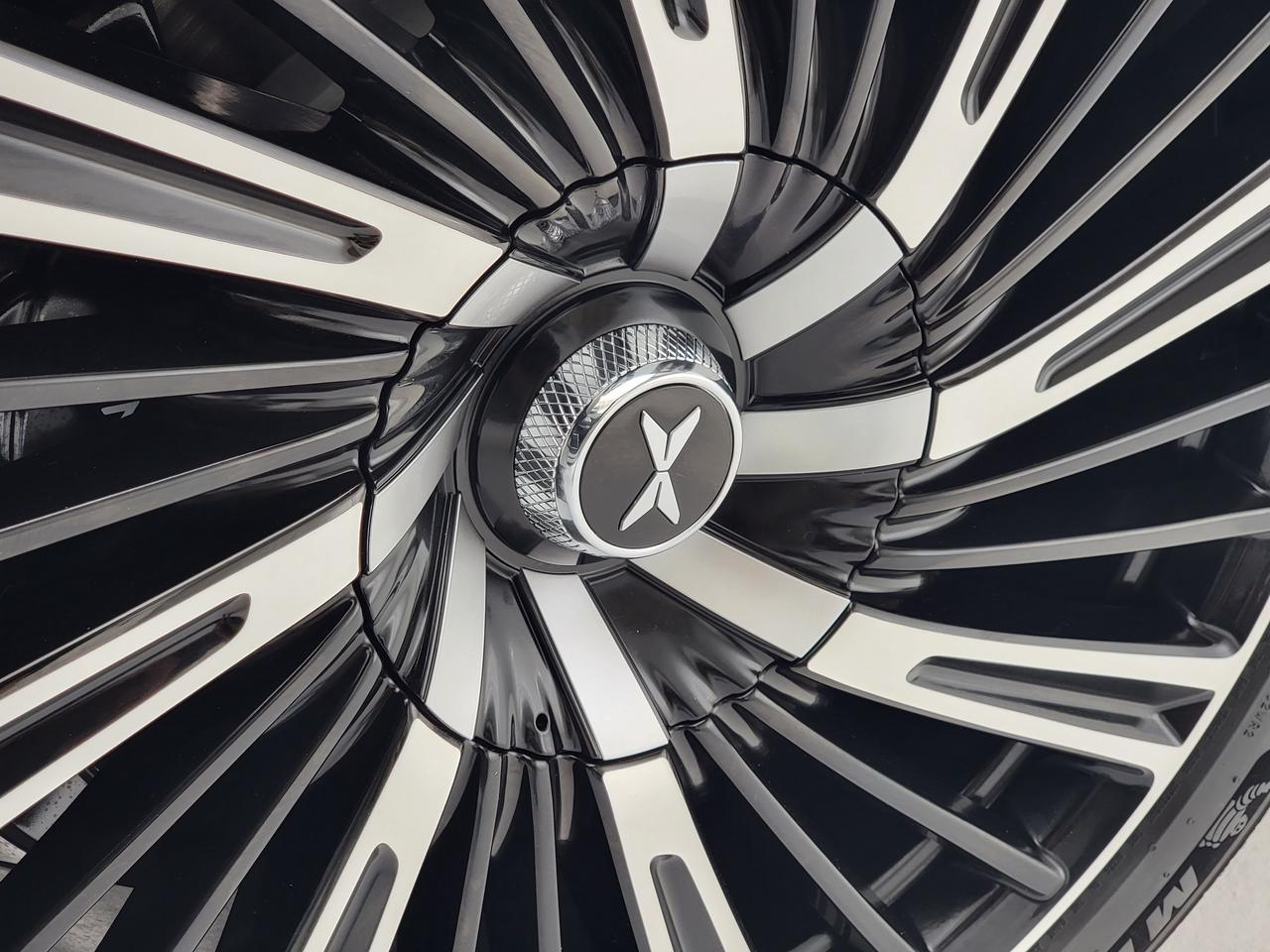
The tire brand still uses Michelin, but this time the G9 uses the PS EV tire designed specifically for electric cars. The PS EV series tire uses high-rigidity rubber in the middle of the tire and low-rolling resistance rubber on both sides to adapt to the greater torque of electric cars and provide better range.
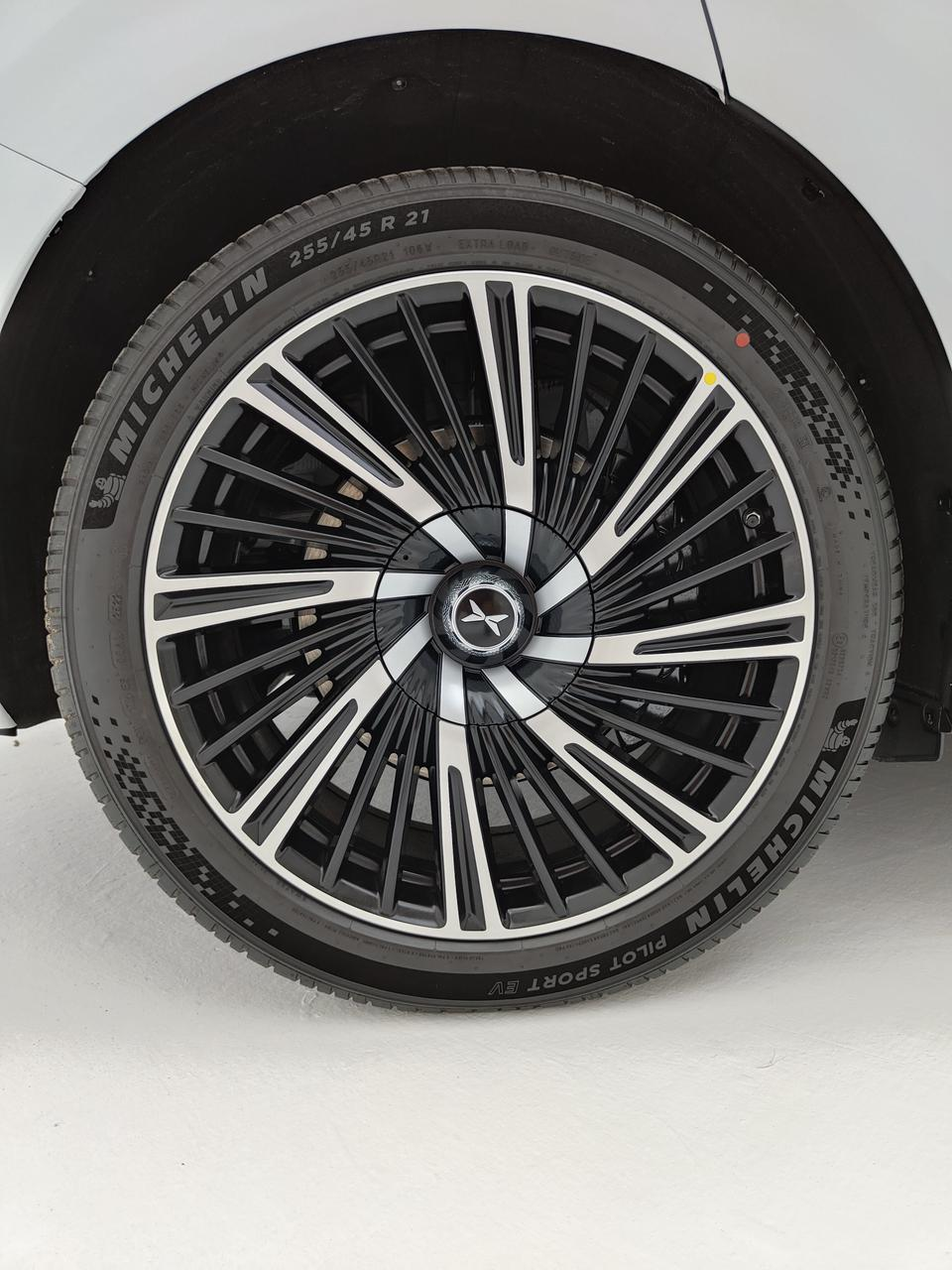
The G9 roof comes with a luggage rack, and the 5G antenna is integrated at the end of the luggage rack, making the entire design seamless.
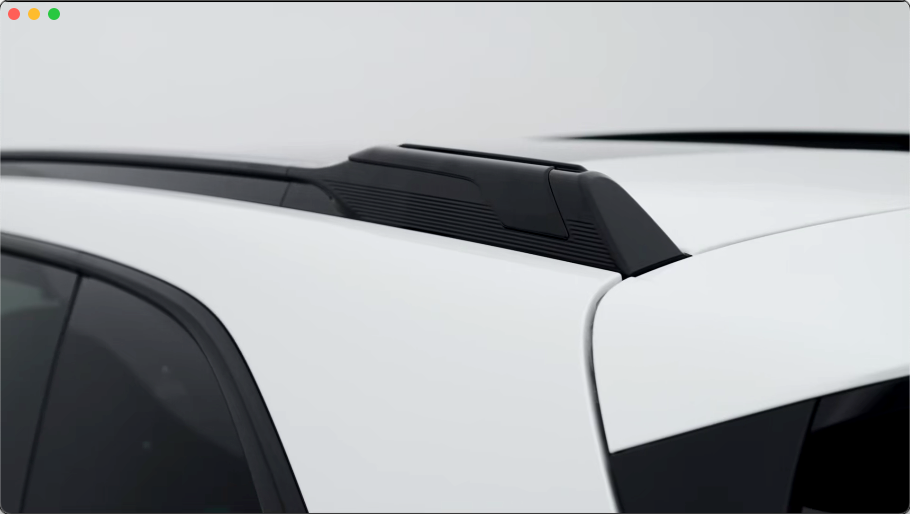
The G9 uses a double-chamber air spring, which can predict road conditions in advance through perception hardware and high-precision maps to proactively adjust the suspension. Compared with the single-chamber air suspension used by the Ideal L9 and the NIO ES7, the double-chamber air suspension is more expensive in cost. We are also looking forward to driving this car on the road and seeing how the chassis suspension performs in practice.

All four doors of the G9 are equipped with electric suction doors, which can be lightly closed to close. However, currently there seems to be some issues with the electric suction logic, and it takes several tries to successfully close the door with the force at which the vehicle will automatically close, so we hope that XPeng can adjust the door closing strategy of the electric suction door to a more suitable force before mass production.
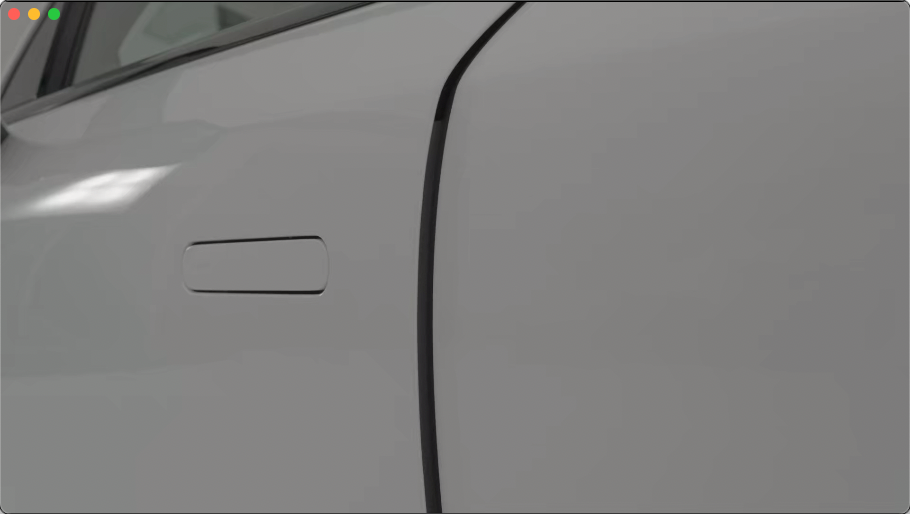
This time, the G9 set the fast charging and slow charging ports on the right rear side of the car body, which are still electric covers like the P7, and added a protective plug to the slow charging port, but for some reason, the fast charging port does not have one. Does XPeng hope that everyone will use the G9’s 800 V high-voltage fast charging more?
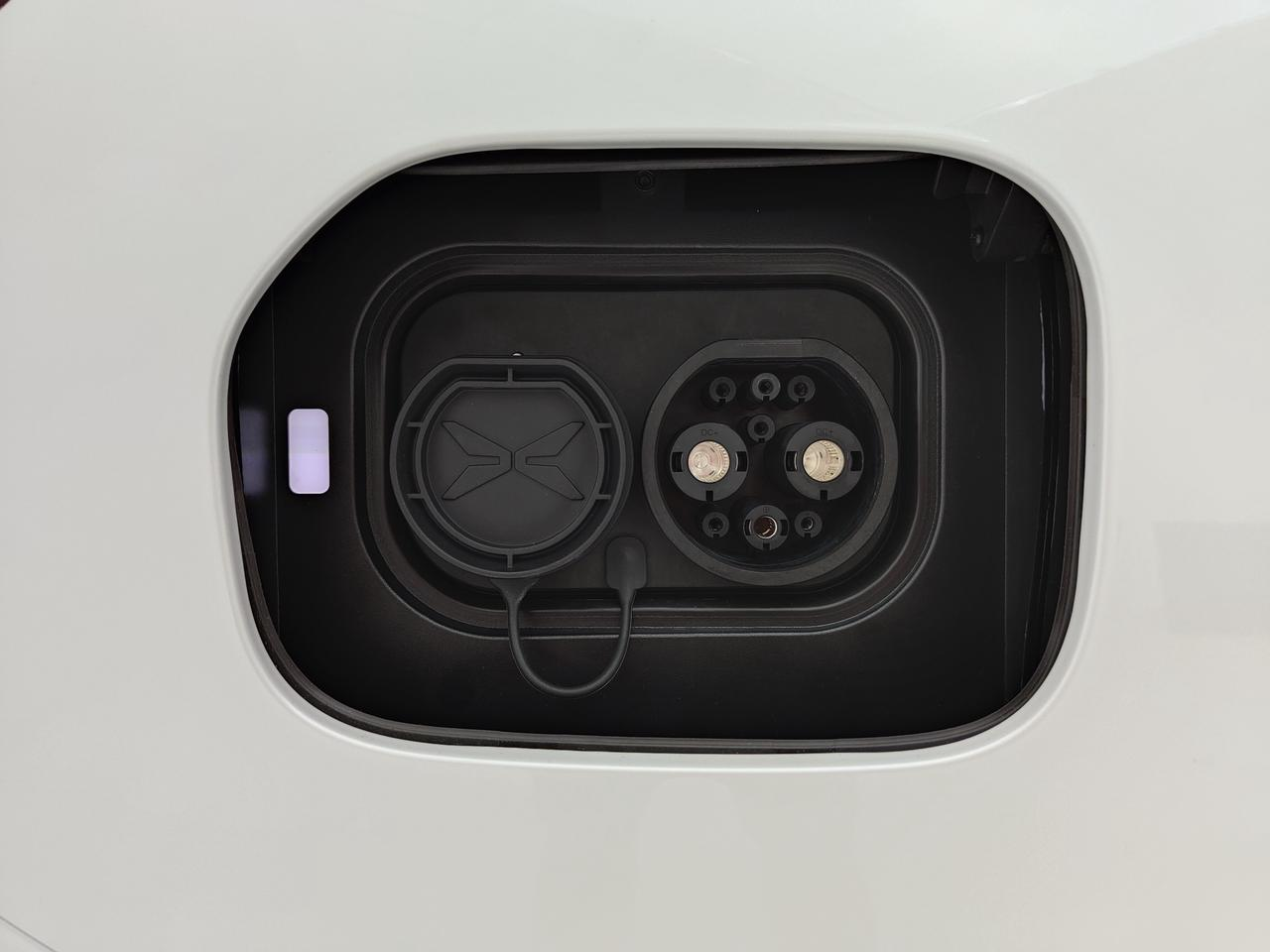 ## Translation
## Translation
When it comes to the rear of the car, the first impression it gives off is that it is large. Clearly, XPeng has not designed the rear to be narrower. This kind of design is very common in NIO’s SUV. I believe that some people like it, but my colleague, Reinhart does not like this kind of design. Besides the conventional through-type design, the lower part of the taillight also has many small particle light spots, which look good when viewed up close.
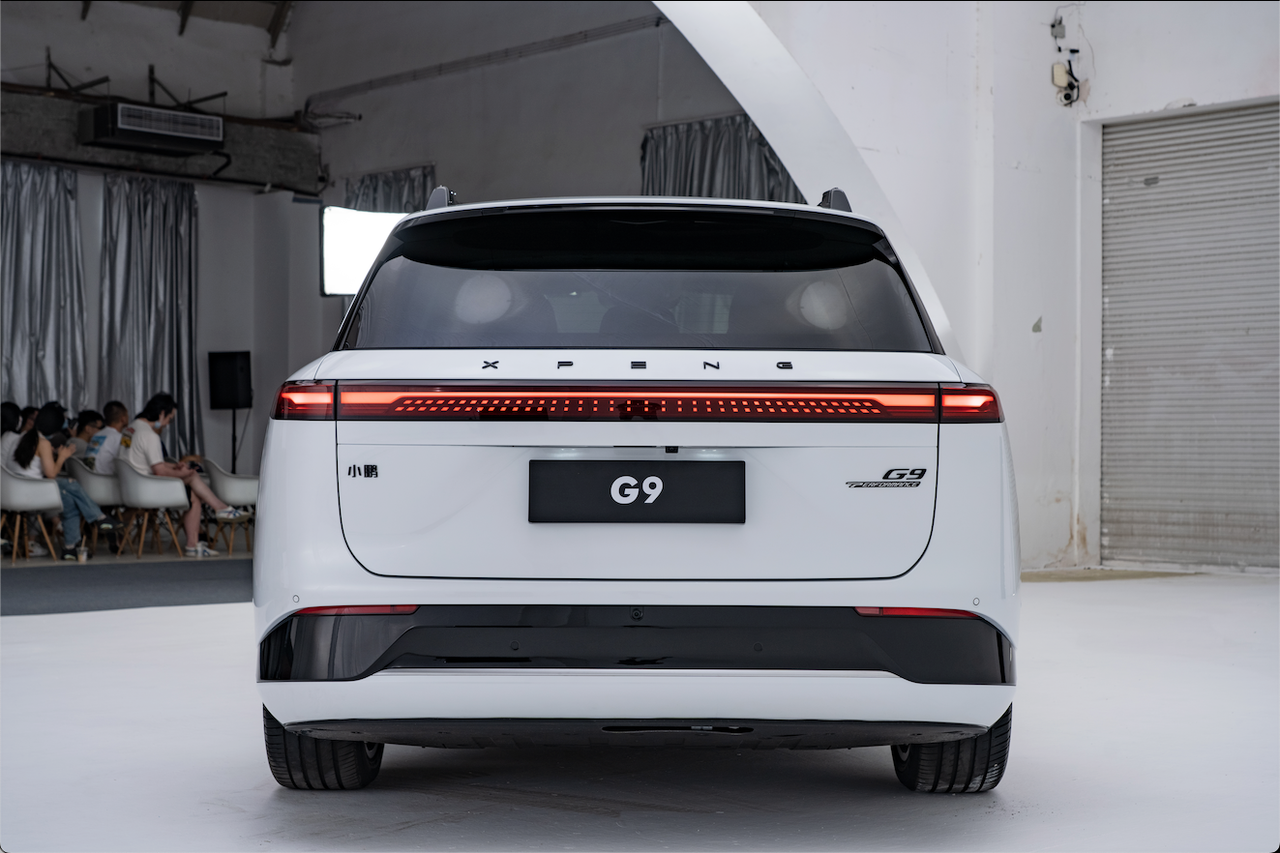
The rear windshield wiper is hidden in the position of the top brake light, to the extent that I thought at first that the car did not have a rear wiper. The hidden rear wiper makes the rear window part look more concise.
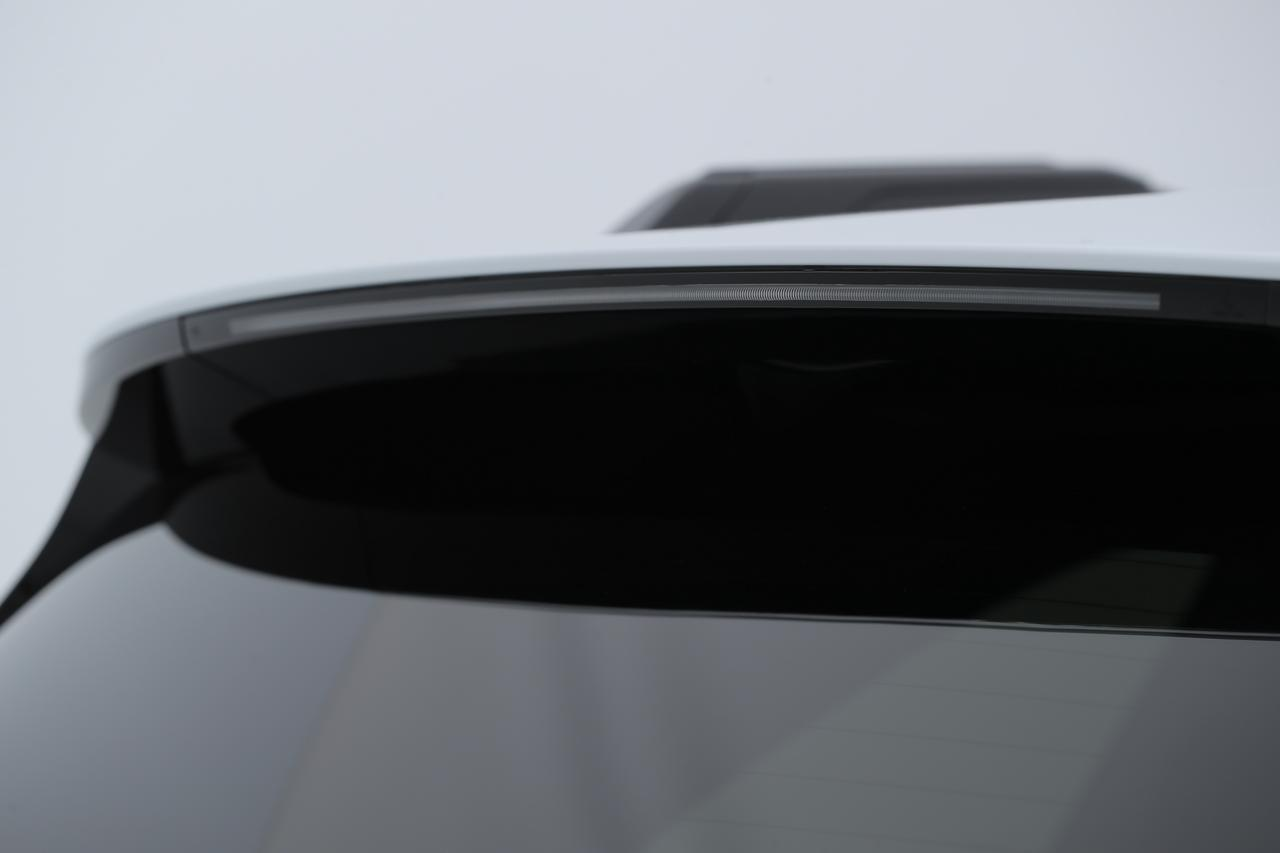
Like the ES7, the G9 also supports trailer function. There is a retractable electric trailer hook at the bottom of the tail, and the maximum trailer weight is 1,500 kg. Due to the impact of the epidemic in the past two years, camping has become popular. XPeng obviously hopes that after purchasing the G9, everyone will bring their family and friends to tow a trailer for camping.
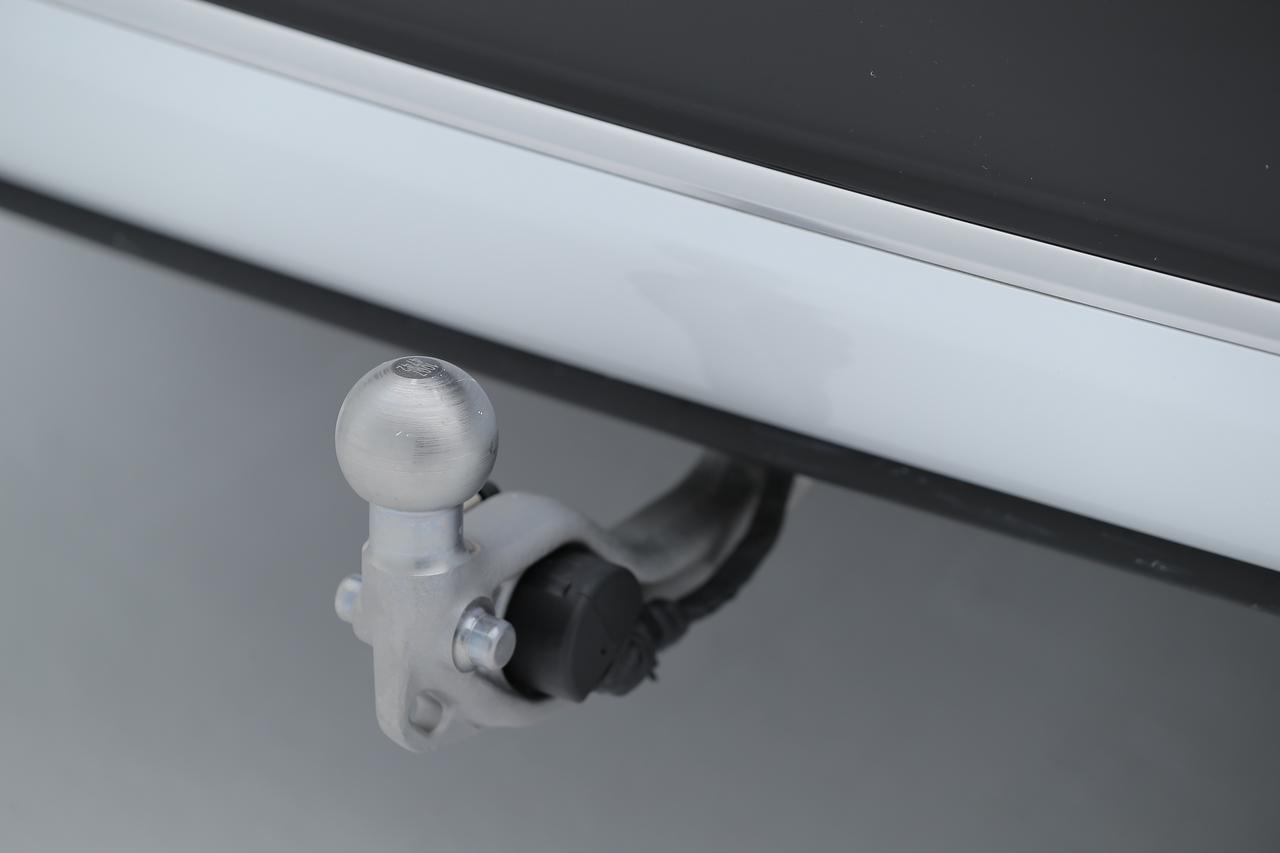
So much for the appearance, now let’s move on to the interior of the car and take a look at how it looks.
Interior Section
When XPeng officially released the interior rendering of the G9, we had already published an analysis article. If you are interested, you can read it first: What is a 5D cockpit? What surprises does the XPeng G9 have? | Interior Analysis. Unfortunately, the display car this time did not use the brown interior that I liked in the official pictures, but black interior. After our actual experience, we found that there are several points of interest in the G9 interior.
Front Seats
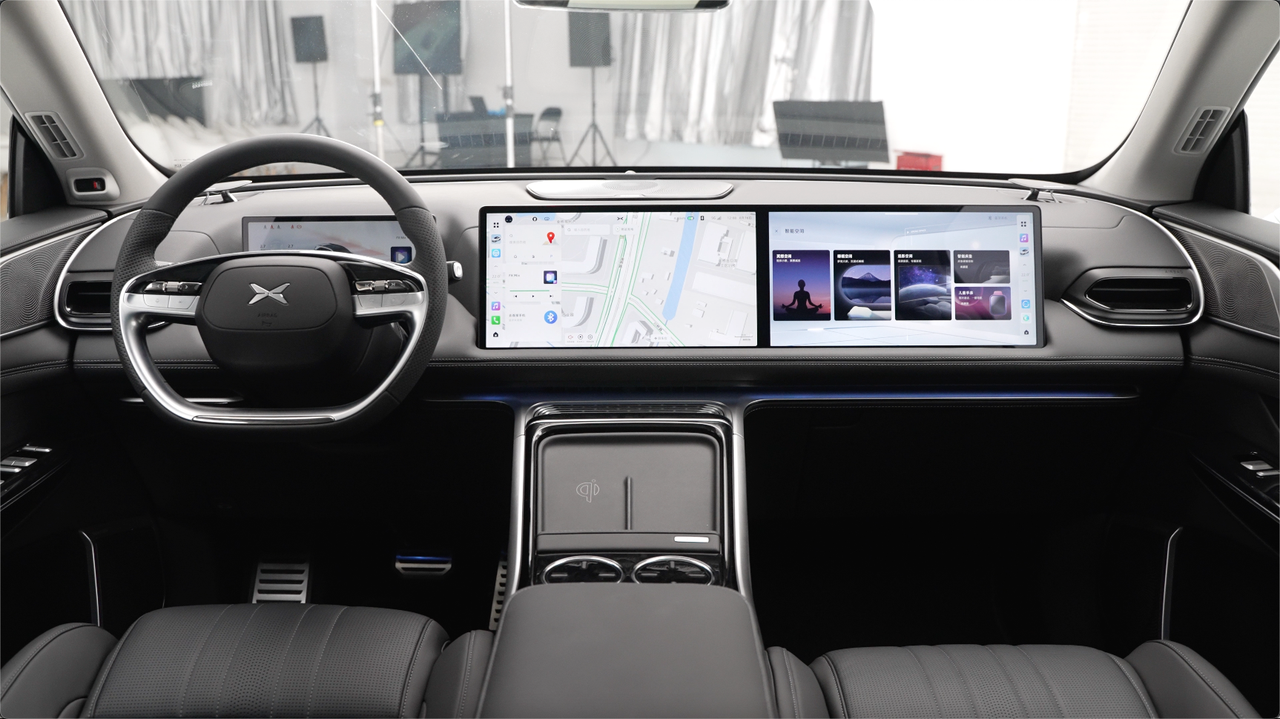
Starting with the steering wheel for the front of the interior, we have known from the previous release of official pictures that XPeng has designed a new steering wheel for the G9. After actually trying it out, I really like this steering wheel design.
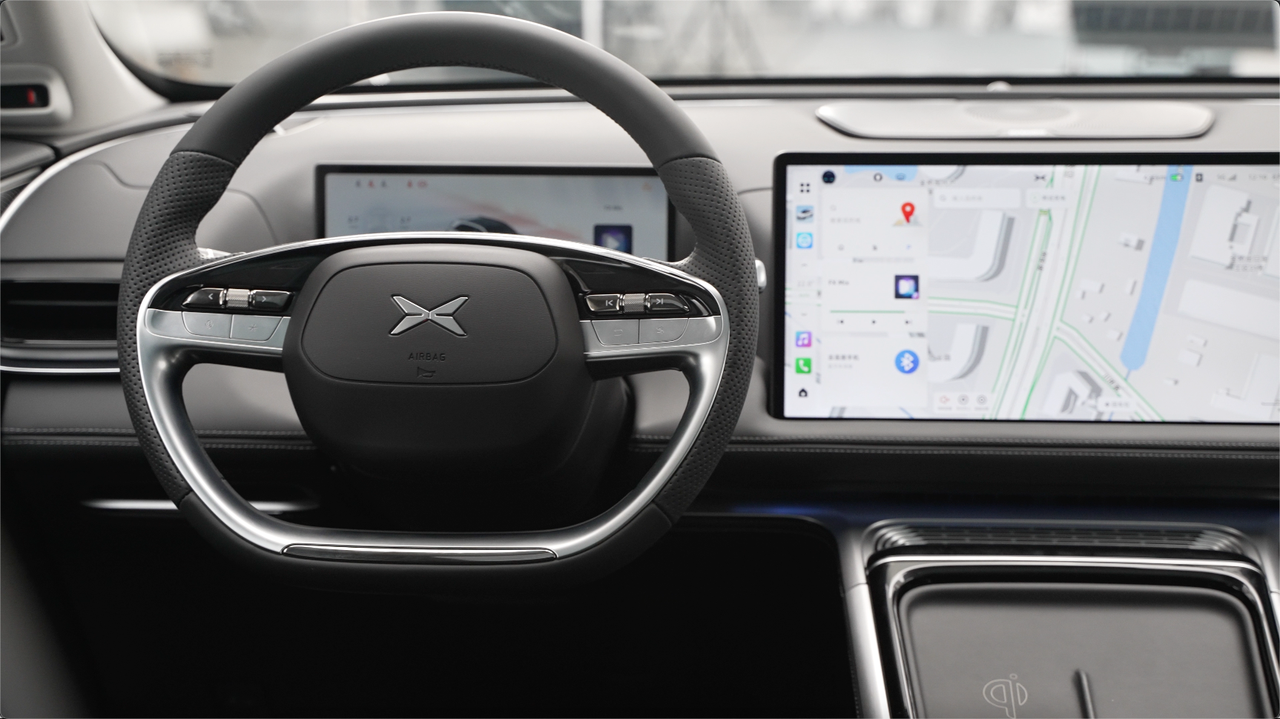
First of all, the entire steering wheel has noticeably become thicker and the grip is much fuller compared to the P7. It feels more “sporty” and is well-aligned with the G9’s positioning as a high-end performance SUV. Additionally, the ring finger and pinkie can now be placed naturally in the grooves at the bottom center of the steering wheel, instead of being left hanging with nowhere to go like on the P7. A shiny chrome strip has also been added to the bottom of the steering wheel, adding a bit of luxury. Furthermore, the steering wheel has been upgraded to use capacitive sensing technology, making driving assistance more intuitive and eliminating the need to constantly twist the wheel.
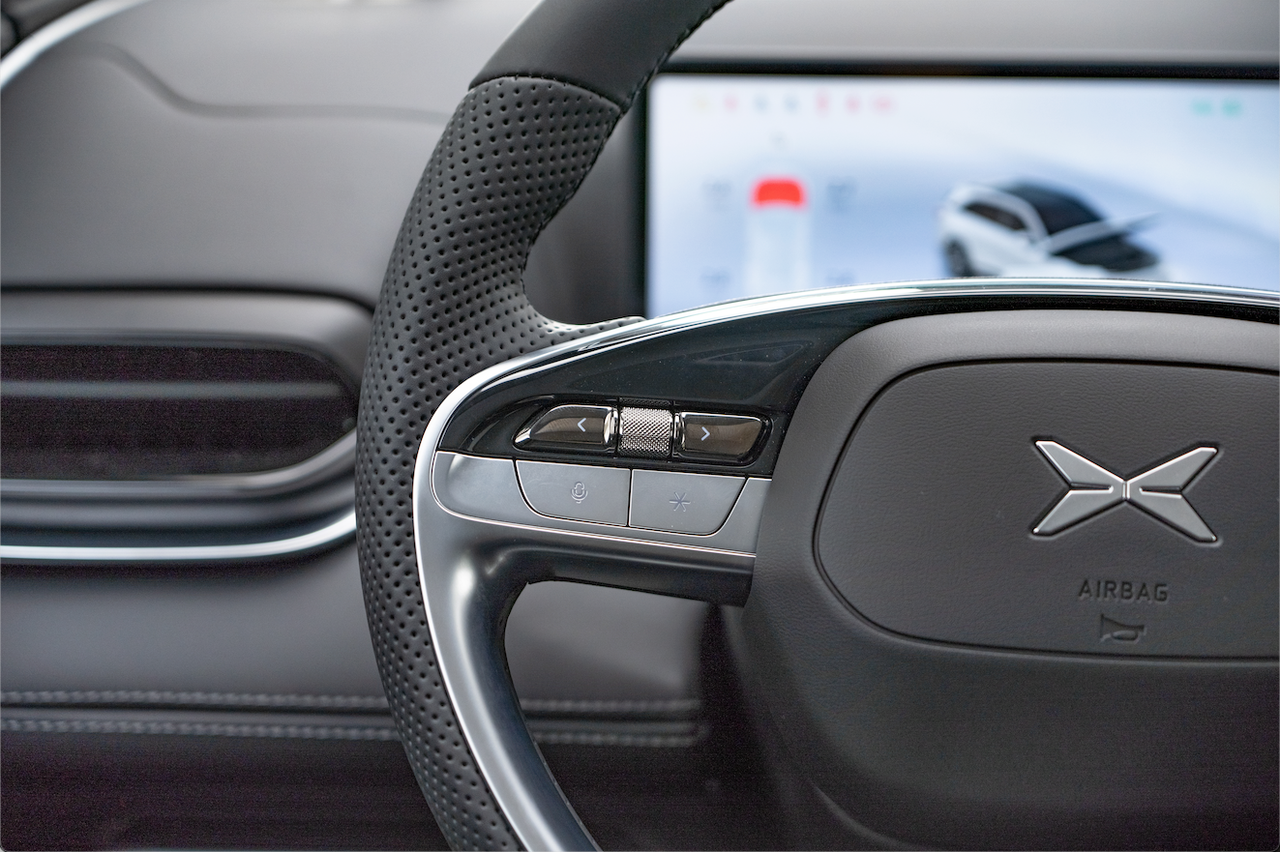
Secondly, the buttons and scroll wheel on the steering wheel are very tactile, with the wheel’s scroll resistance being delicate and making a crisp, audible “click” when moved. The physical buttons have a strong, distinctive feedback when pressed, unlike the vague, spongy feeling on the P7.
The G9 finally supports electronic adjustment and memory for the steering wheel, which I believe is a must-have feature for high-end vehicles. The adjustment is done via two scroll wheels on the steering wheel. Additionally, the range of adjustment available for the steering wheel’s forward and backward movement is very extensive, which is great for drivers like Reinhart who have long legs and like to rest their elbows on the door panel or central armrest.
The gear lever on the back of the steering wheel looks no different from the P7 at first glance, but actually, the resistance of the lever has been recalibrated by XPeng, and a turning lever auto-reset feature has been added. This means you no longer need to manually reset the lever like on the P7 when using the turn signal during assisted driving.
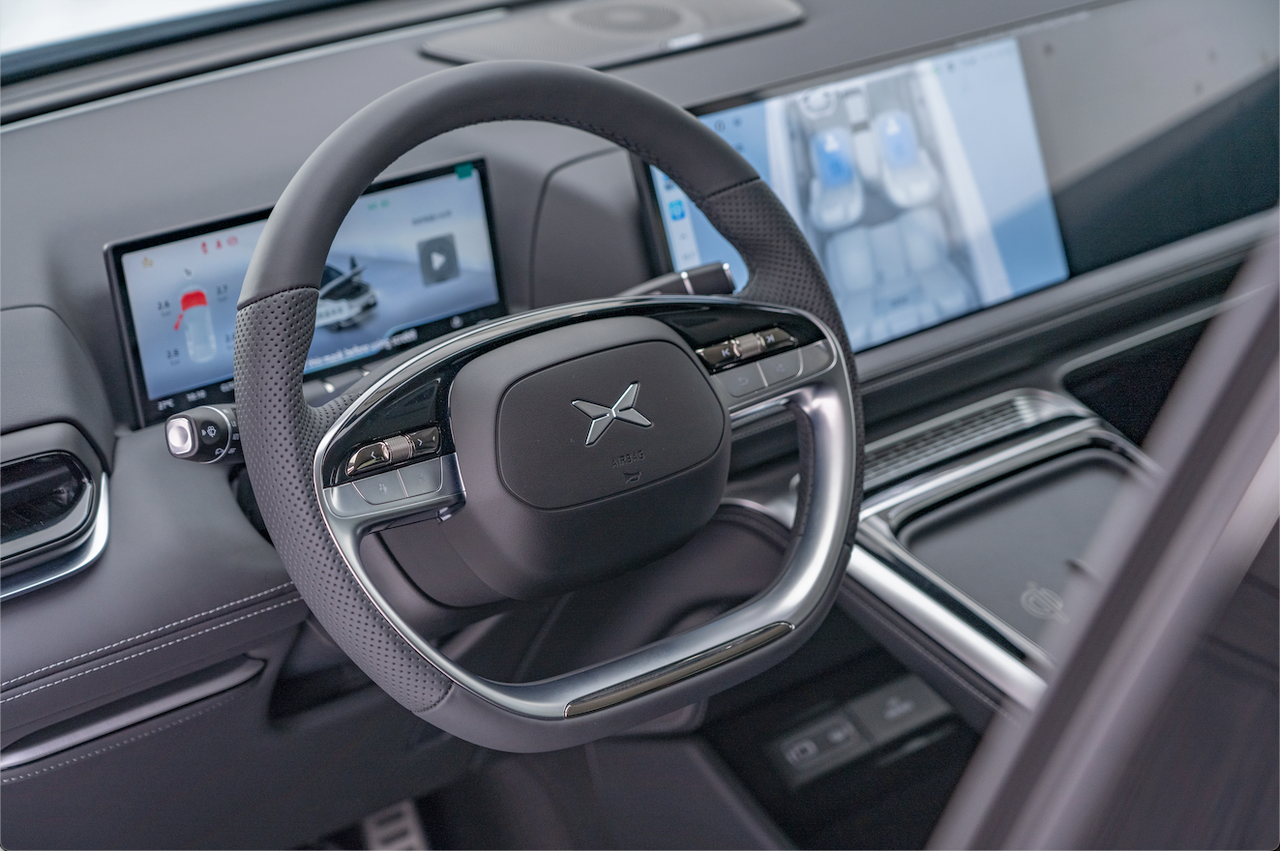
Although the instrument panel, central control screen, and passenger screen all maintain the same resolution as the P7, the bezels have been noticeably slimmed down. However, perhaps because the software is still in the engineering version, the left side of the screen has rounded corners while the right side has right angles. It is hoped that this issue can be fixed via an OTA update in the future.
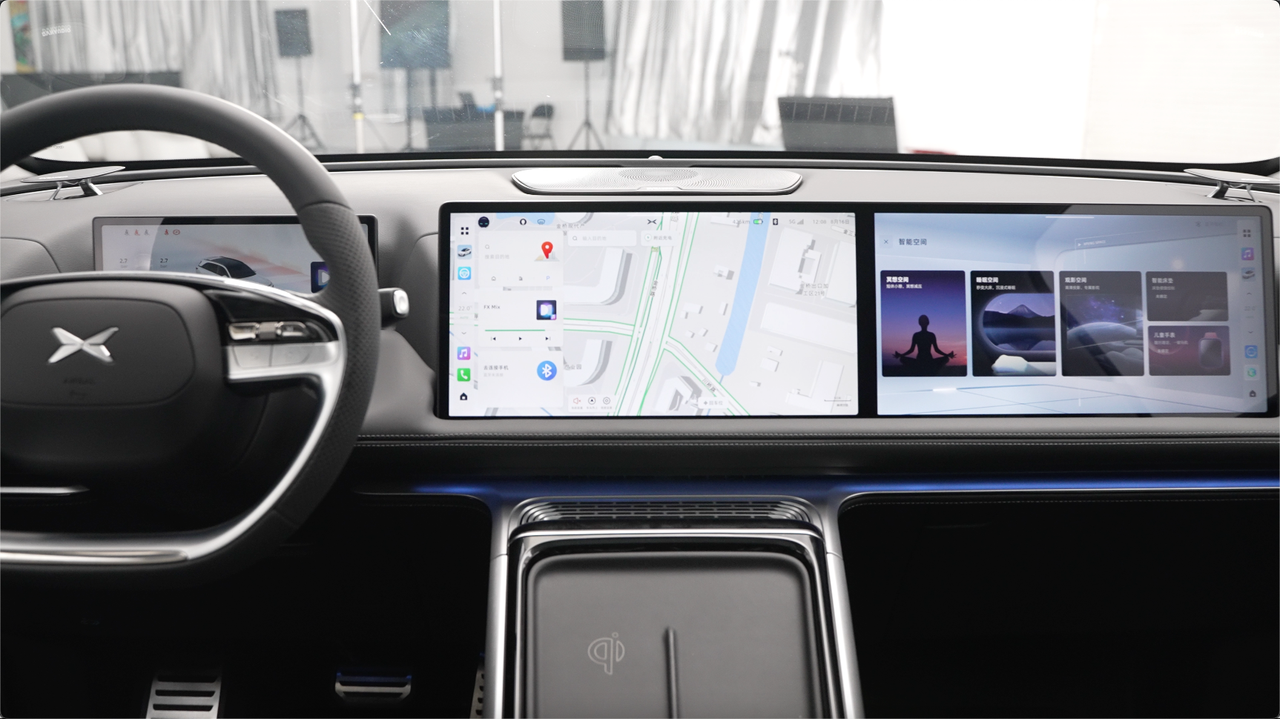
The overall fluency of the infotainment system is on par with the normal level of the 8155 chip. However, when pictures of the UI were released previously, many people criticized it for being ugly. In reality, the design of the icons on the right dock is indeed somewhat inconsistent. However, when entering the settings menu, clicking on different menu items will trigger a 3D vehicle model animation effect, which is quite well done. Currently, this car is still in the engineering protoype stage, so I’m confident that the entire infotainment system will perform even better when it goes into mass production.The central control screen and the co-pilot screen both support two-finger dragging for part of the content. When the central control screen is playing music or video, the content can be directly slid to the co-pilot screen for continued playback by using the two-finger sliding gesture. Conversely, the content can also be slid from the co-pilot screen to the central control screen. However, what needs to be criticized is that the co-pilot can also change the vehicle settings at will. Isn’t this design a bit unreasonable?
Next, let’s talk about other noteworthy parts. The main driver’s thigh support can be extended up to 50 mm, which provides better support for the driver’s legs. However, our 1.8-meter-tall editor Reinhart tried it and felt that it didn’t really help him.
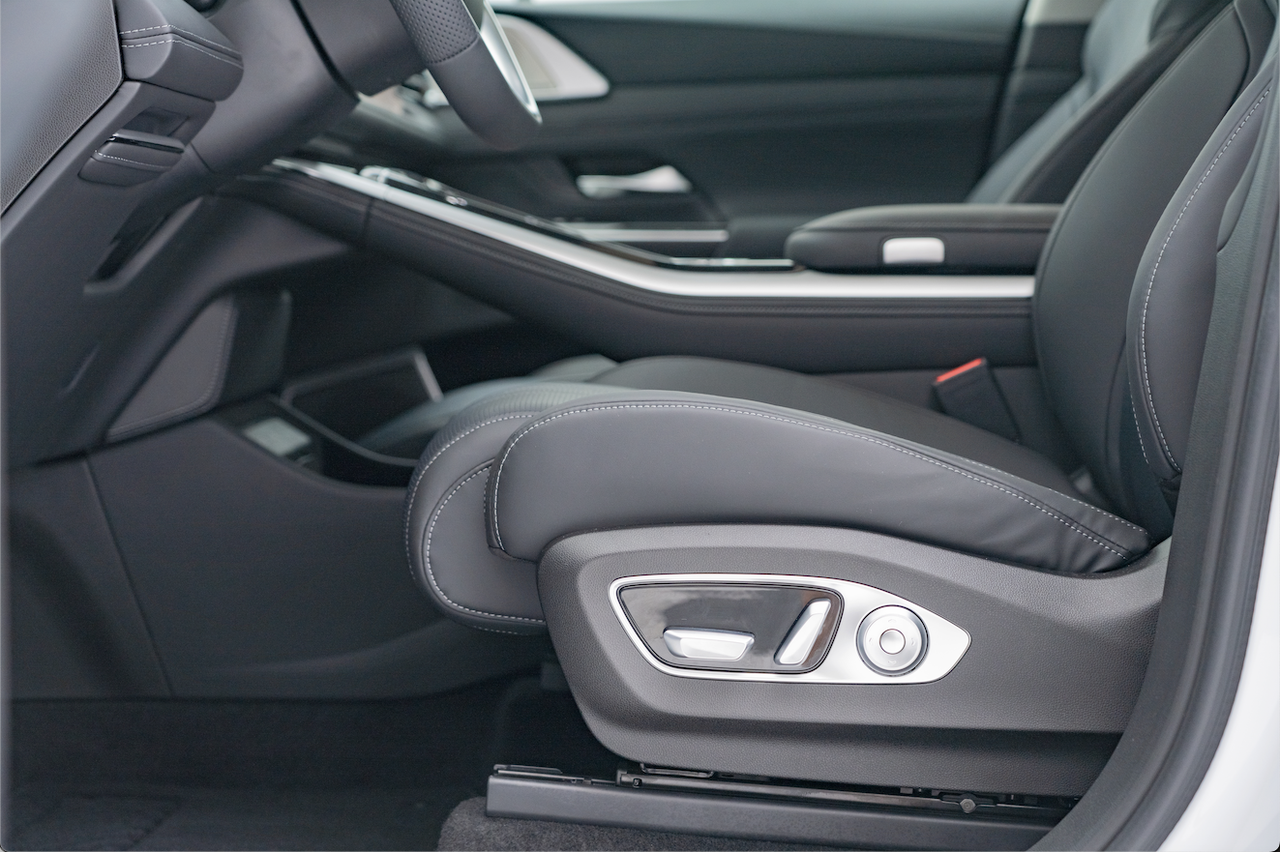
The seat ventilation is finally not just on the configuration table like in the P7 model. After turning on the three levels of seat ventilation, it feels very obvious. The accelerator and brake pedals are made of metal, which is also one of the characteristics of high-end cars.
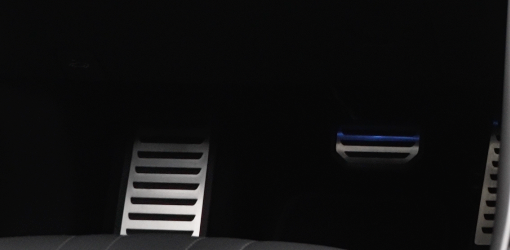
The storage space on the door panel is not large, and it can only hold two water bottles at most. However, there is a hollow storage space in the center which can accommodate shoes, handbags, and other items. The central armrest box has a button on both the driver’s and co-pilot’s side, which can be opened in different directions. The depth of the armrest box is good enough to store some receipts and sundries. The glove box is still opened by a manual button and is slightly larger than the one in the P7. In addition, there is a glasses case near the reading light in the G9, and the overall storage space is much better than that of the P7.
The ambient lights in the G9 are all hidden-designed, which does make it more atmospheric compared to the exposed light strip in the P7.

The co-pilot’s leg rest is indeed very comfortable, but for normal adult men who want to fully stretch their legs, the seat needs to be adjusted backward a bit. The front seats were tried for massage for a short time and felt good with a strong massage intensity.
The cup holder which can be raised and lowered in the central armrest position makes the central area appear simple when there is no water cup, but it is not very friendly for people like me who like to put sundries on the cup holder. The G9’s fragrance is placed in the armrest box, but due to the nature of the engineering car, even if the fragrance is turned up to the strongest, it can only be smelled near the air outlet. I hope that XPeng Motors can optimize this in the future.
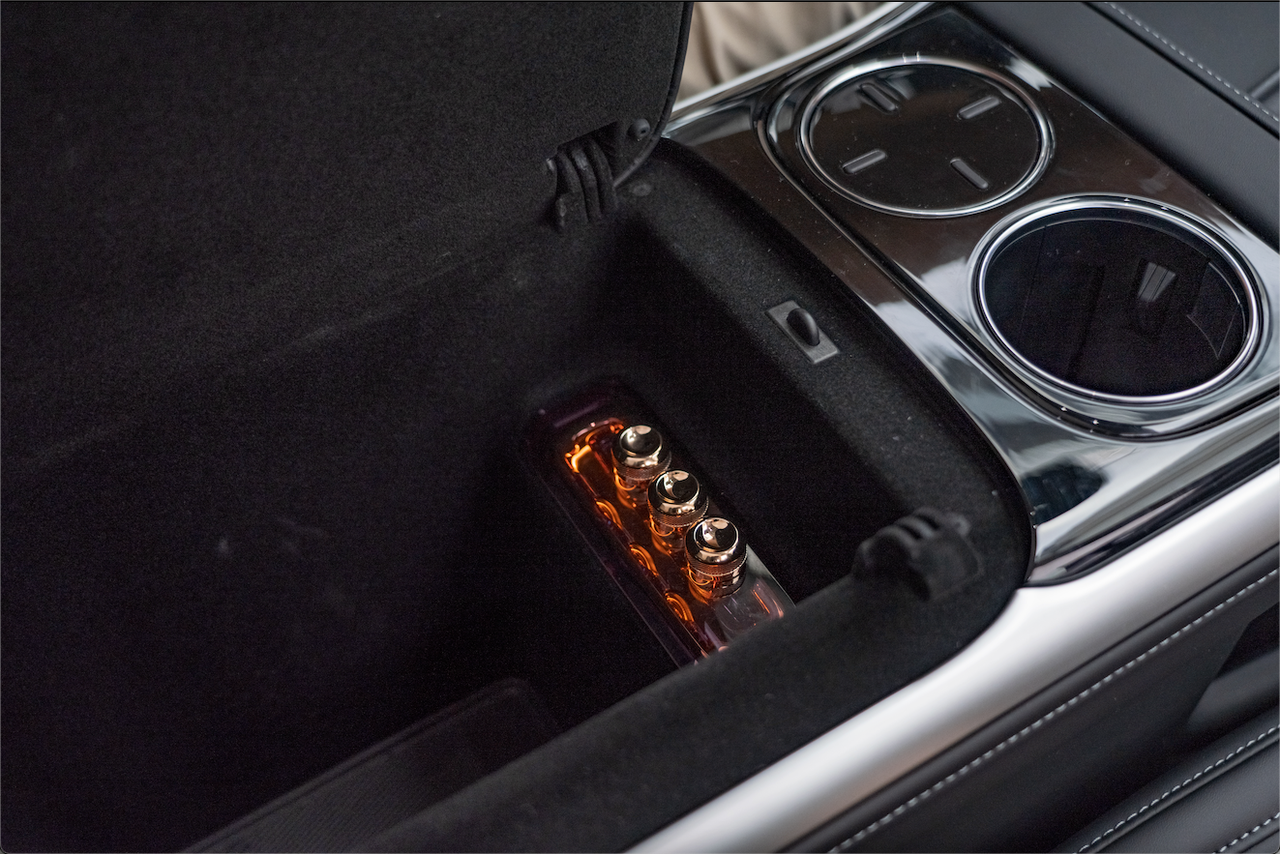 In terms of the use of soft materials, the G9 is extravagant. Not only has it used a lot of leather wrap in areas that come into contact with the body, but also in places that are only seen in daily life. Only soft plastic materials are used in very remote areas. Even the roof handle of the car is wrapped in leather. Looking at this, the G9 has indeed achieved “high-end”.
In terms of the use of soft materials, the G9 is extravagant. Not only has it used a lot of leather wrap in areas that come into contact with the body, but also in places that are only seen in daily life. Only soft plastic materials are used in very remote areas. Even the roof handle of the car is wrapped in leather. Looking at this, the G9 has indeed achieved “high-end”.
There is a USB-A port with a maximum of 2.4 A charging and a USB-C port that supports a maximum of 60 W charging in the central hollow storage area. There’s also a 12 V cigarette lighter interface with a maximum power of 180 W for use with in-car fast charging.
Additionally, there is a USB-A interface on the right side of the G9’s reading light, which is likely to be used to power the non-plug ETC, just like the P5. Hopefully, the G9 will come with a driving recorder, so that users don’t have to install another one on the windshield.
Rear Seat
When I first learned about the G9’s three-dimensional parameters and spy photos, I always doubted the G9’s rear seat space. The body size of the G9 is 4,891 x 1,937 x 1,670/1,680 mm (the optional air suspension vehicle height is 1670 mm), and the wheelbase is 2,998 mm. Compared with the P7, the length, width, and wheelbase of the G9 are almost identical, and judging from the spy photos, the rear seat space is not particularly large. But when I actually sat in the back seat, all my doubts disappeared.
The first impression I got when I sat in the back seat was that the G9 did indeed meet its positioning as a “large five-seat” SUV. My height is 1.76 meters, and when I sat in the rear seat, I had about two fists of legroom. When the seat angle was 37 degrees, the headroom was about four fingers, and the rear passenger space was spacious. The fillers on both sides and the middle seat are relatively soft, giving a feeling of a “Japanese-style big sofa”. However, the middle backrest is relatively hard, and sitting in the middle seat for a long time can be uncomfortable.
In addition, the G9 also supports electric seat adjustment between 27 and 37 degrees, and the control button for folding down the seat is on the door panel. The actual experience of folding down the seat is indeed more relaxing. At the same time, the rear seats also have heating and massage functions, making them very user-friendly for long-distance travel. There is a boss key on the left side of the front passenger seatback, which makes it easy for the rear right passenger to adjust the front passenger seat.In addition, the sleep space on P5 has been extended to G9. Although there are no mattresses available on site to lay down, we still tried the “one-click folding” function of all car seats. First, find the corresponding entrance in the car’s system, and then follow the prompts to complete the steps. However, since the folding function of the rear seats is mechanical rather than electric, it takes some effort to restore the seats to their original state, which may be a bit challenging for girls with weaker strength.
G9 has been upgraded from P7’s dual-tone area voice recognition to quad-tone area recognition. Now, the rear seats can also activate the voice assistant through voice commands. However, there is a slightly embarrassing situation. If the rear seats are folded down and you want to use the voice assistant, it may be recognized as a command initiated from the rear seats, resulting in the inability to operate certain functions that cannot be used in the rear seats.
Trunk
This time, the tailgate of G9 finally has a regular opening button, but I didn’t find a way to open it with a foot kick sensor. The trunk comes with a removable cover, and after testing with my arm, it has a depth of about more than half of my arm’s length. If the cover is removed, it can easily accommodate luggage for the whole family’s travel. Even after folding down the rear seats, it can easily carry a small house.

There is a hook on the left side of the trunk with a maximum load of 3 kg, two buttons for folding down the seats on the right side, two buttons for controlling the suspension lift, a lighting lamp, and a 12V maximum power of 180 W external power outlet. There are also two net pockets on the left and right sides for storage.
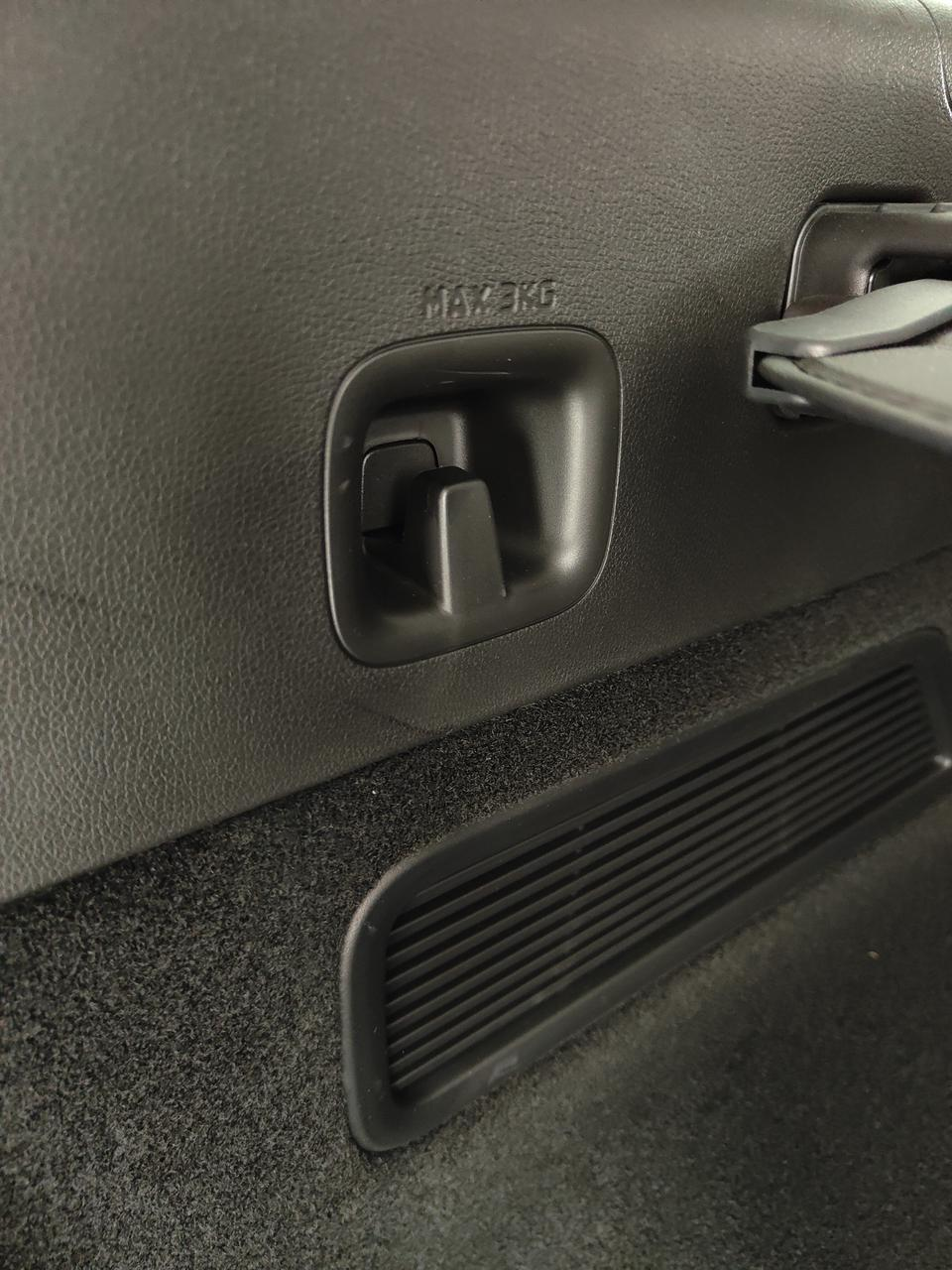
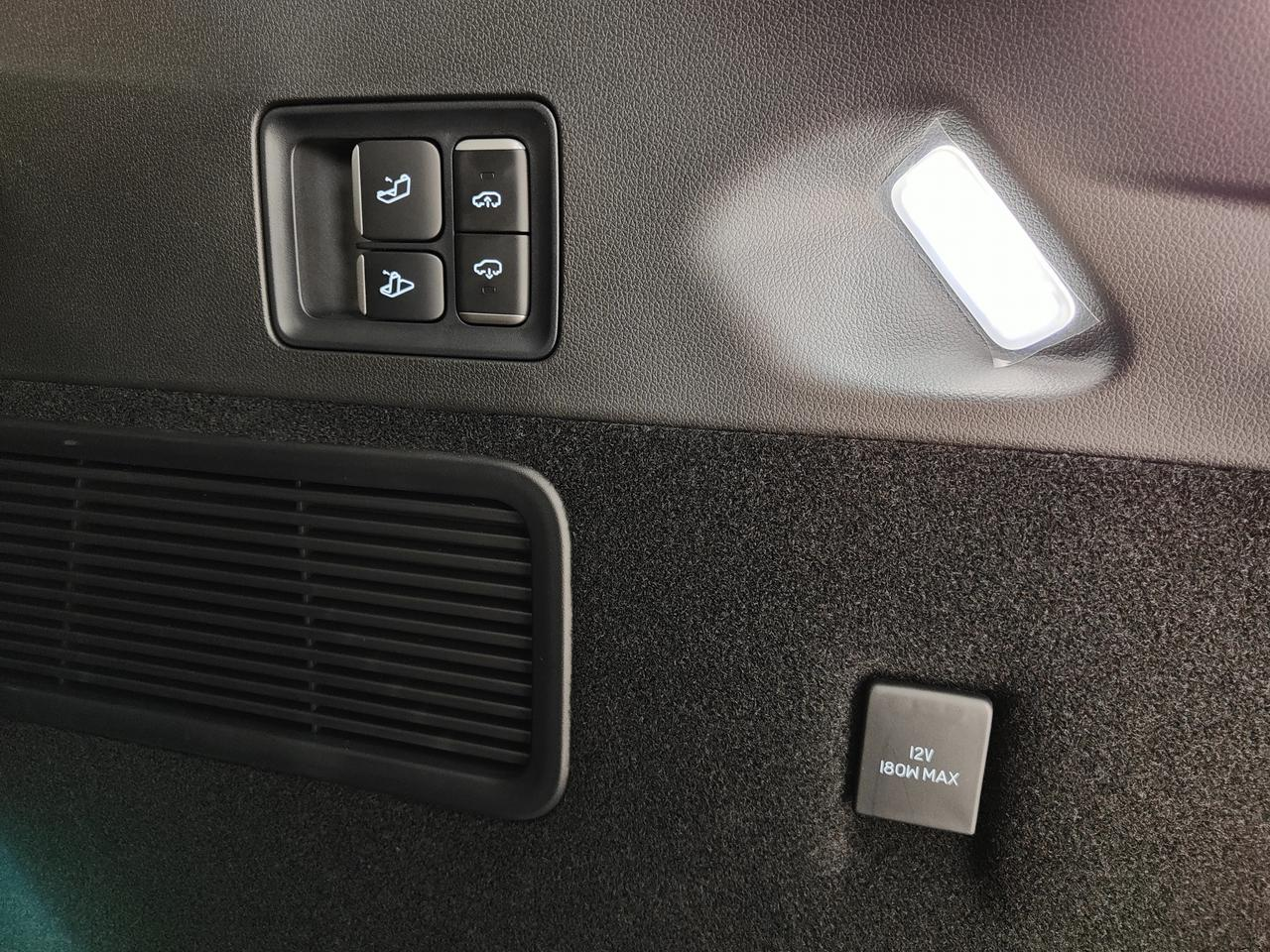
There is a partition in the trunk, and some tools are placed below it. However, this area still has plenty of space, and more tools or rarely used car accessories can be placed here.
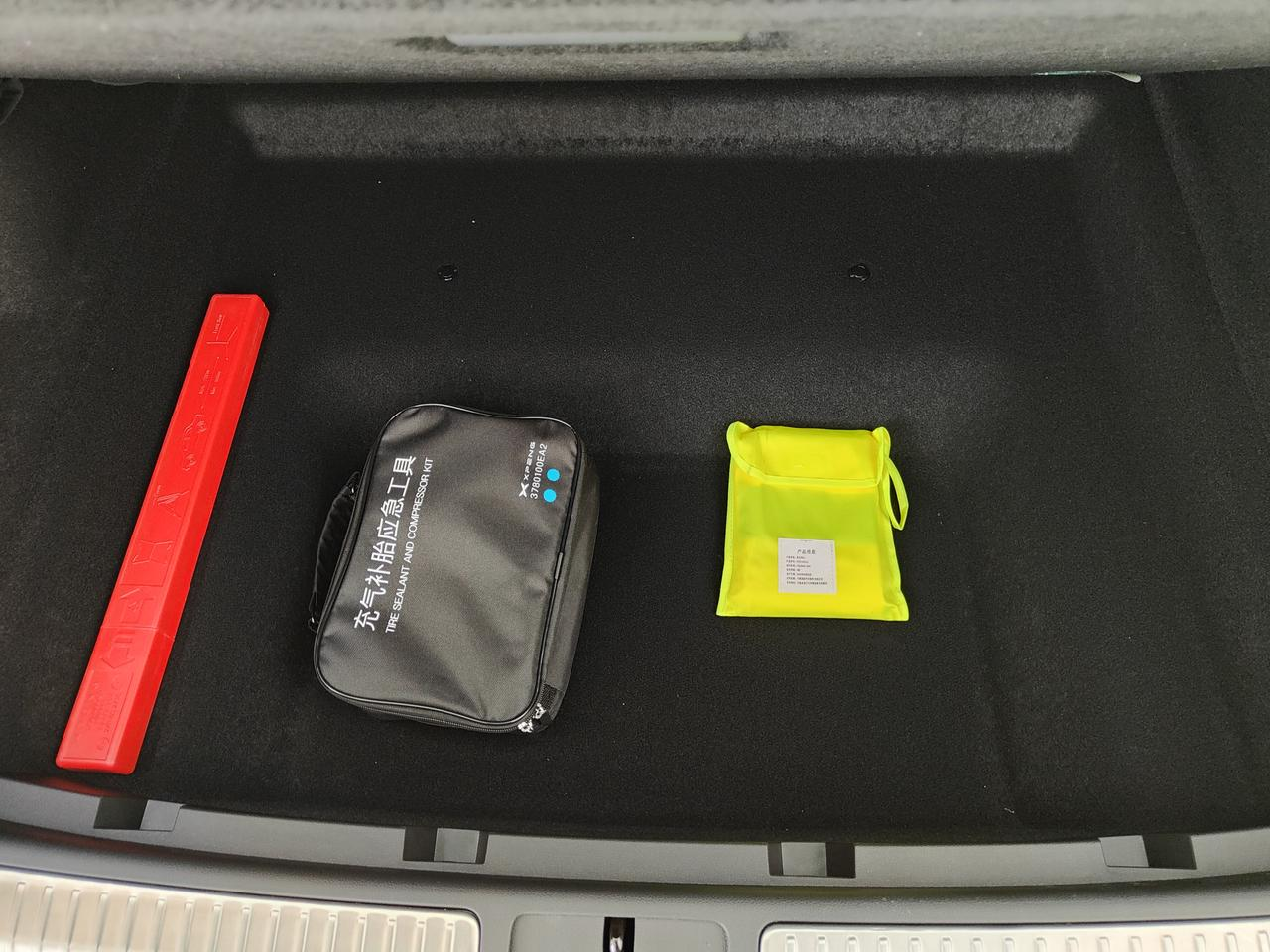
Cabin Audio
Starting with NIO ET7’s standard 1,000W audio system, car companies have started to not only stack auxiliary driving hardware on cars, but also stack audio systems. This time, XPeng has even promoted “XOPERA: XPeng Music Hall” on the G9. So, let’s talk about the cabin audio system separately.For drivers, before fully automated driving technology is achieved, most of the attention is inevitably still focused on driving. Therefore, the only entertainment drivers can enjoy while driving is auditory, so the quality of the car’s sound system becomes particularly important.
Let’s take a look at the main parameters of the G9 sound system:
- 28 acoustic units, including 18 Dali original Confidence high-end sound systems, 6 seat vibration units, 2 driver-specific speakers, and 2 external speakers.
- Maximum power of 2,250 watts.
- 7.1.4 multi-channel music system.
- Dolby panoramic sound technology.
Just from the parameters, it can be seen that Xpeng attaches great importance to the car’s sound system this time, and almost every configuration has reached the ceiling of current car audio.
In addition, Xpeng has also proposed the concept of “5D Music Cabin”, which simply means adding air conditioning, fragrances, and seat linkage on the basis of the sound system.
When we played the film “Dune” adapted for “5D experience” on iQiyi in the car, when we played the part of night sneaking, the seats would heat up and vibrate with the explosion of the spacecraft in the video, making people feel like they were immersed in the heat of the spacecraft exploding and burning.
When we played a demonstration video of a roller coaster in the car, when it dropped from the highest point, the air conditioning also increased, making it possible to restore the feeling of the wind howling past when riding a roller coaster.
After experiencing the movie, we randomly played a song on QQ Music to test the performance of this sound system playing regular music sources, and the results were very shocking. When playing music, the G9 sound system not only has a wide sound field, but the analysis of music does not show any obvious decline, which is different from other sound systems with wide sound fields. Reinhardt even directly gave the evaluation of “the best listening experience among new forces in recent times”. Moreover, when we listen to music, we can clearly feel the feeling of bass sound waves hitting our legs.
In general, the G9’s “music hall”-level audio system is truly worthy of the name. Even though I have previously heard exceptional audio systems from the NIO ET7 and the Li Xiang L9, I was still impressed by the setup of Dynaudio speakers in the G9. To be frank, the audio system is the most impressive aspect of the G9 in my mind.
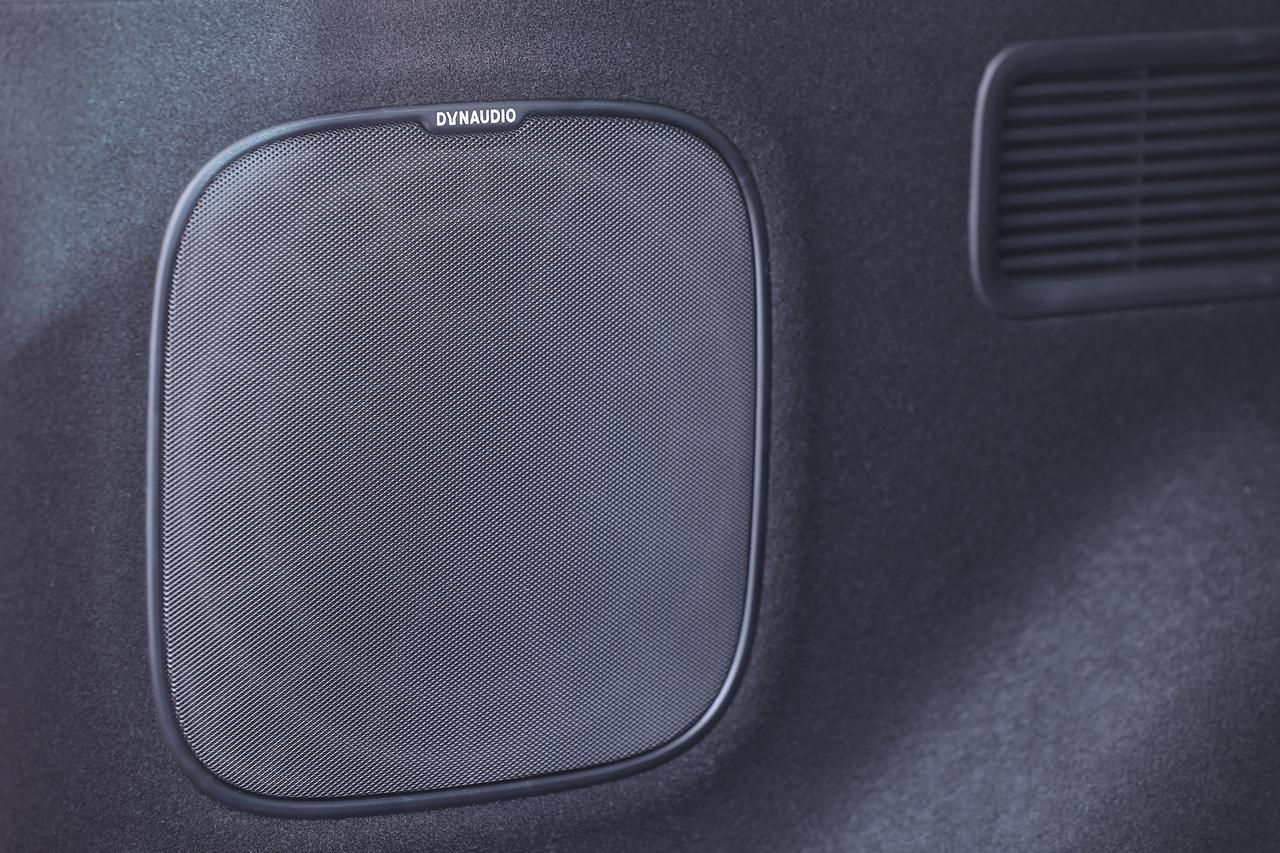
Competitors on the Prowl
So far, we have covered pretty much everything regarding the static experience of the XPeng G9. There is no doubt that the G9 is the strongest flagship model of XPeng at present. However, it also faces formidable competitors.
We do not know the pricing range of the G9 yet, but we expect it may fall within the range of 300,000 to 450,000 RMB. In this price bracket, the most direct competitor is obviously the NIO ES11, and above that there is the Li Xiang L9 and NIO ES7, all of which are tough contenders. Let’s first take a look at the comparison of the four vehicles’ appearances.
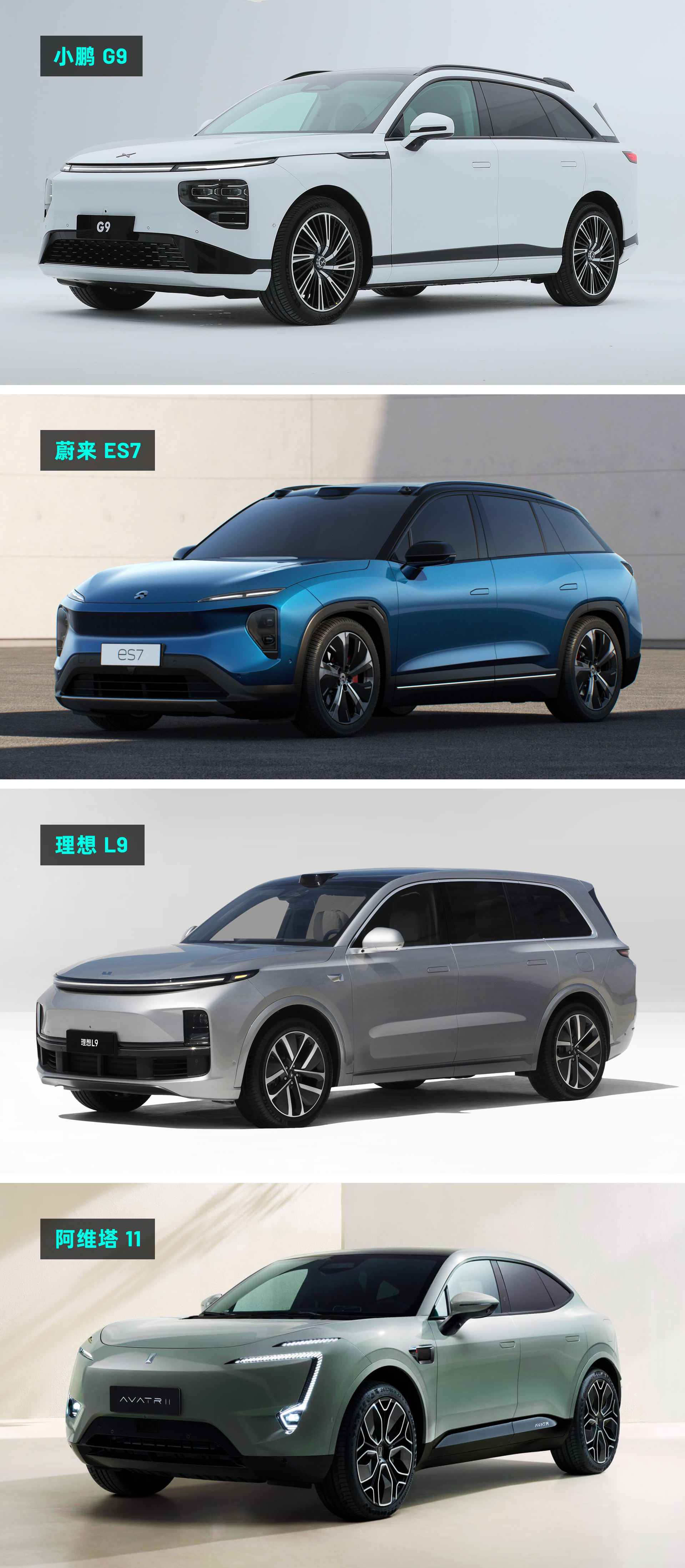
As for the exterior, everyone has different preferences, and we will not go into much detail here. Which car’s appearance do you like the most? Please feel free to share your thoughts in the comment section.
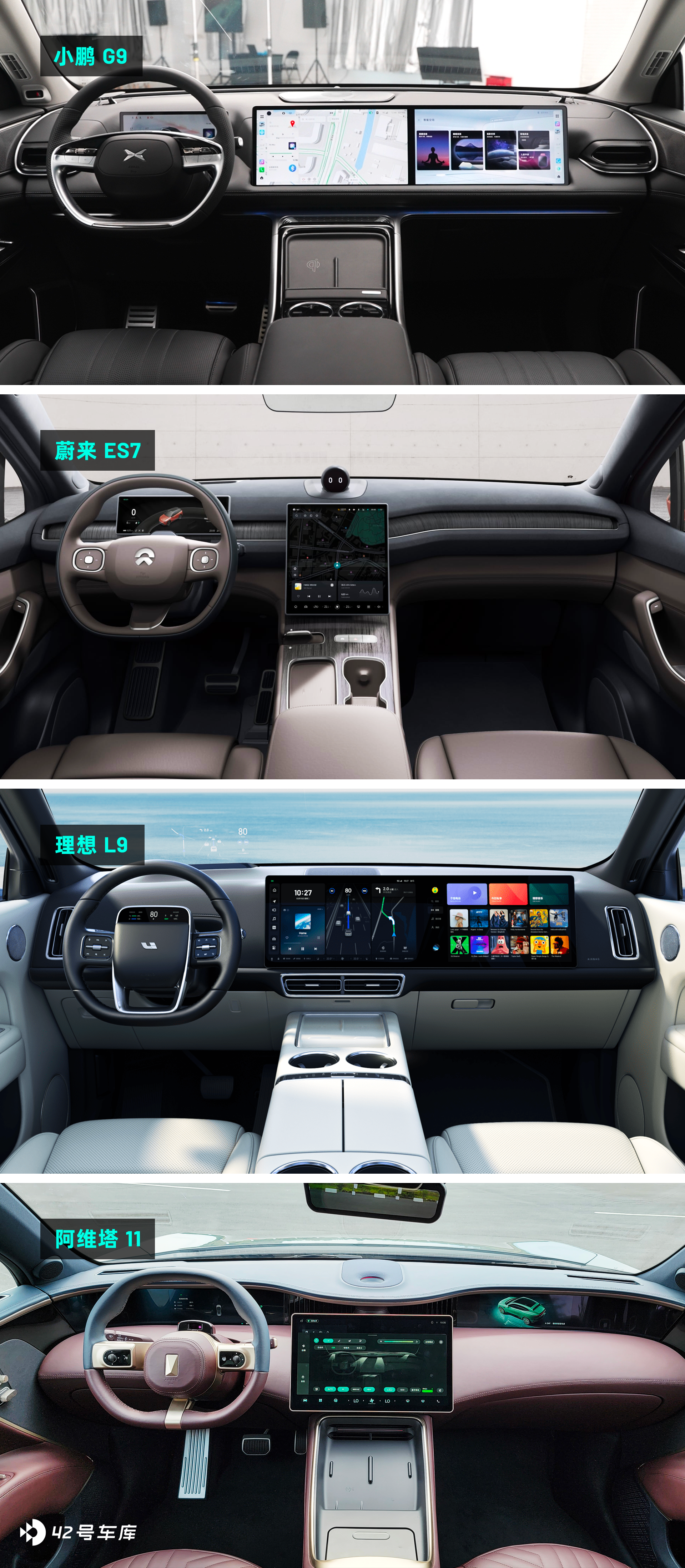
For the interior, we can see that each manufacturer has a different interpretation of luxury. Except for the NIO ES7, the other three models are equipped with a co-pilot screen. The Li Xiang L9 has canceled the main driving instrument panel and instead used a small touchscreen together with a large-sized HUD. In addition, the NIO ES7 also has HUD function, while the XPeng G9 and the Avita 11 do not have HUD.
The seating configurations are shown in the figure below. Except for the Li Xiang L9, all other models are “large five-seater” SUVs. The Li Xiang L9 has the most diversified seating configuration, while the XPeng G9 and NIO ES7 are basically the same except for the boss button. The Avita 11’s 4-seater version is similarly luxurious, but the 5-seater version only has adjustable seat angles in the rear.
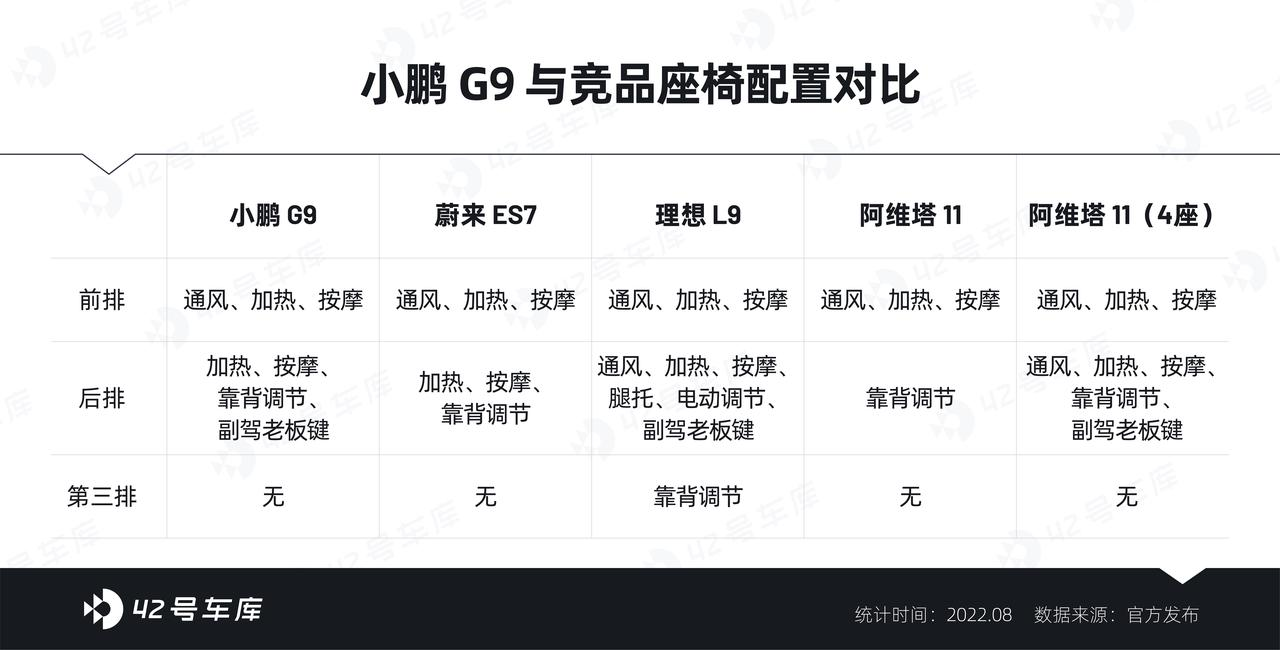
In terms of powertrain, except for the Li Xiang L9, the acceleration of the other three vehicles is within 4 seconds per 100 kilometers, qualifying them as sporty SUVs. The Li Xiang L9 is positioned as a full-size 6-seater SUV, so its acceleration of slightly over 5 seconds per 100 kilometers is more than enough.The configuration of ADAS hardware is shown in the following picture. All four cars are equipped with lidar and high-pixel cameras, and the assisted driving hardware capabilities are at the flagship car level.
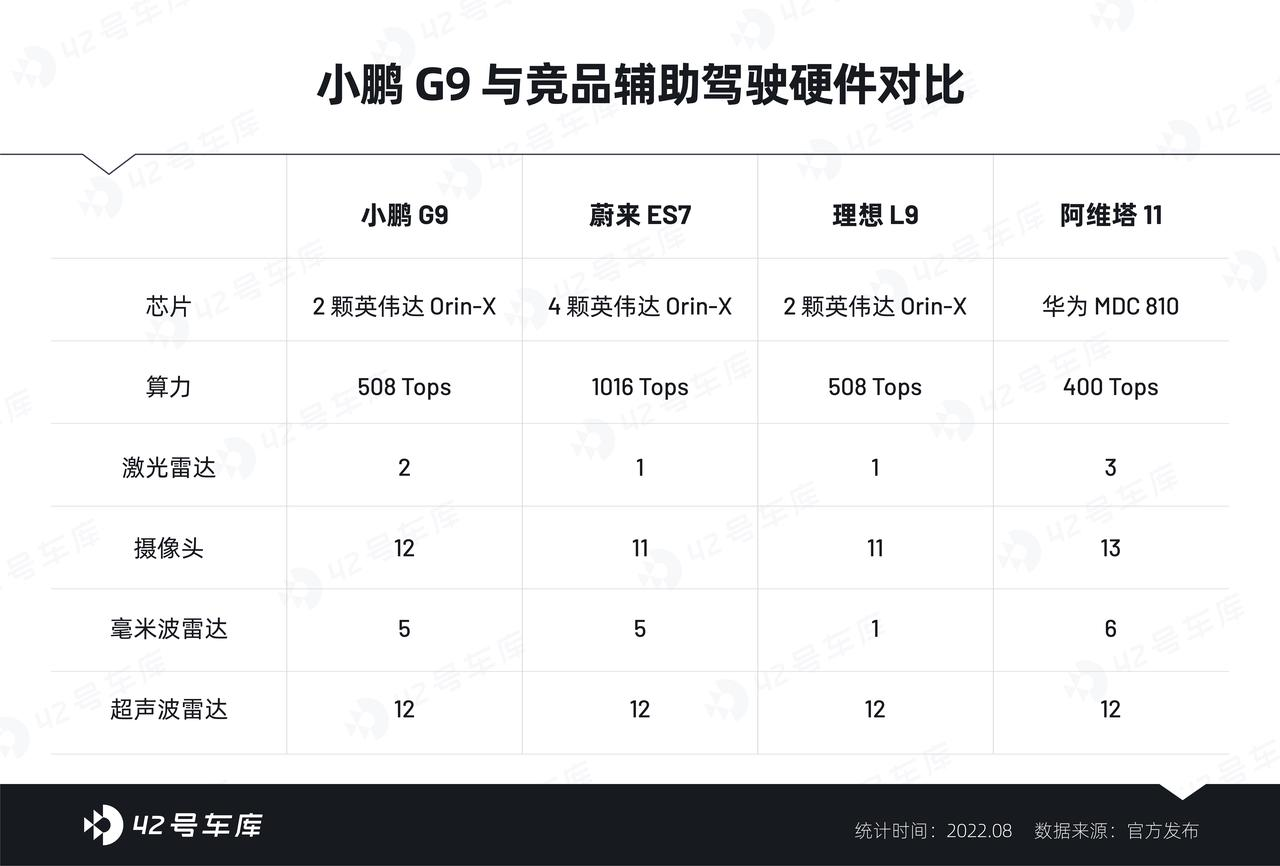
The cabin audio configuration is shown in the following picture. The three new forces all have very luxurious audio configurations, but compared with them, the configuration of AVATAR 11 is slightly inferior.
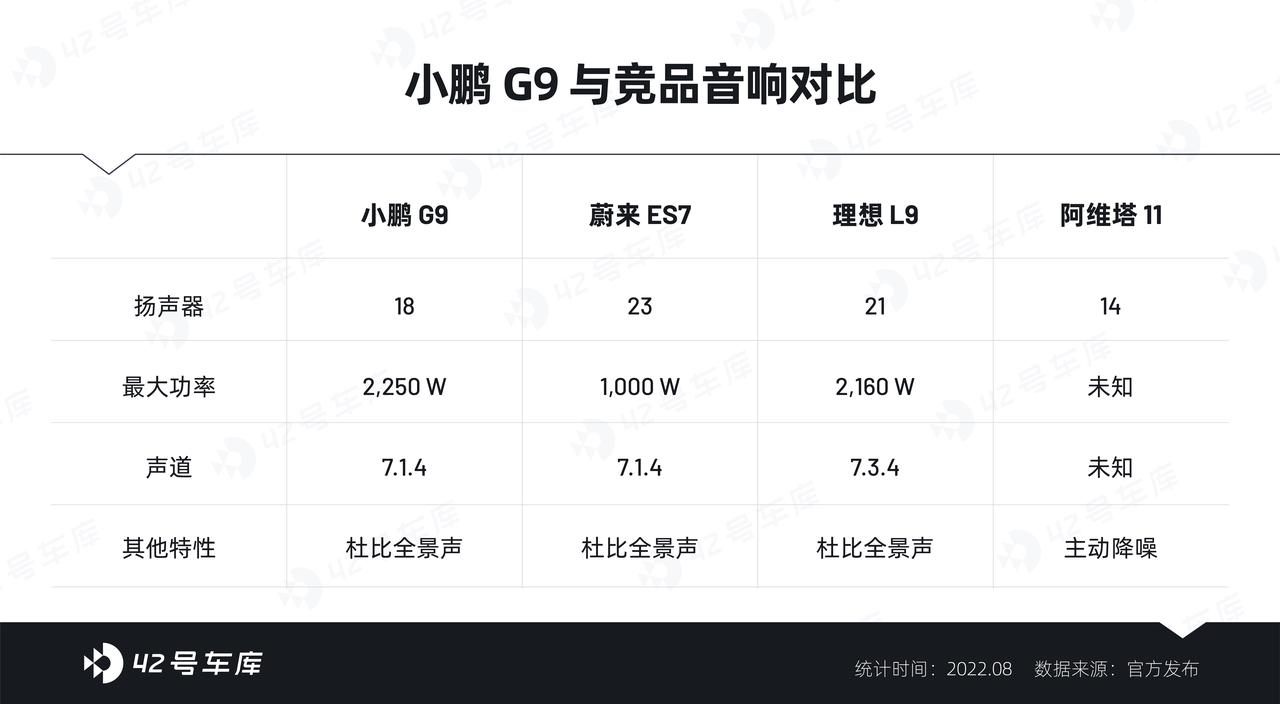
In summary, in terms of the main hardware configuration, XPeng G9 is not inferior to other flagship SUVs. If XPeng can offer a “sincere” price at the press conference, G9 is expected to achieve very good sales.
In conclusion,
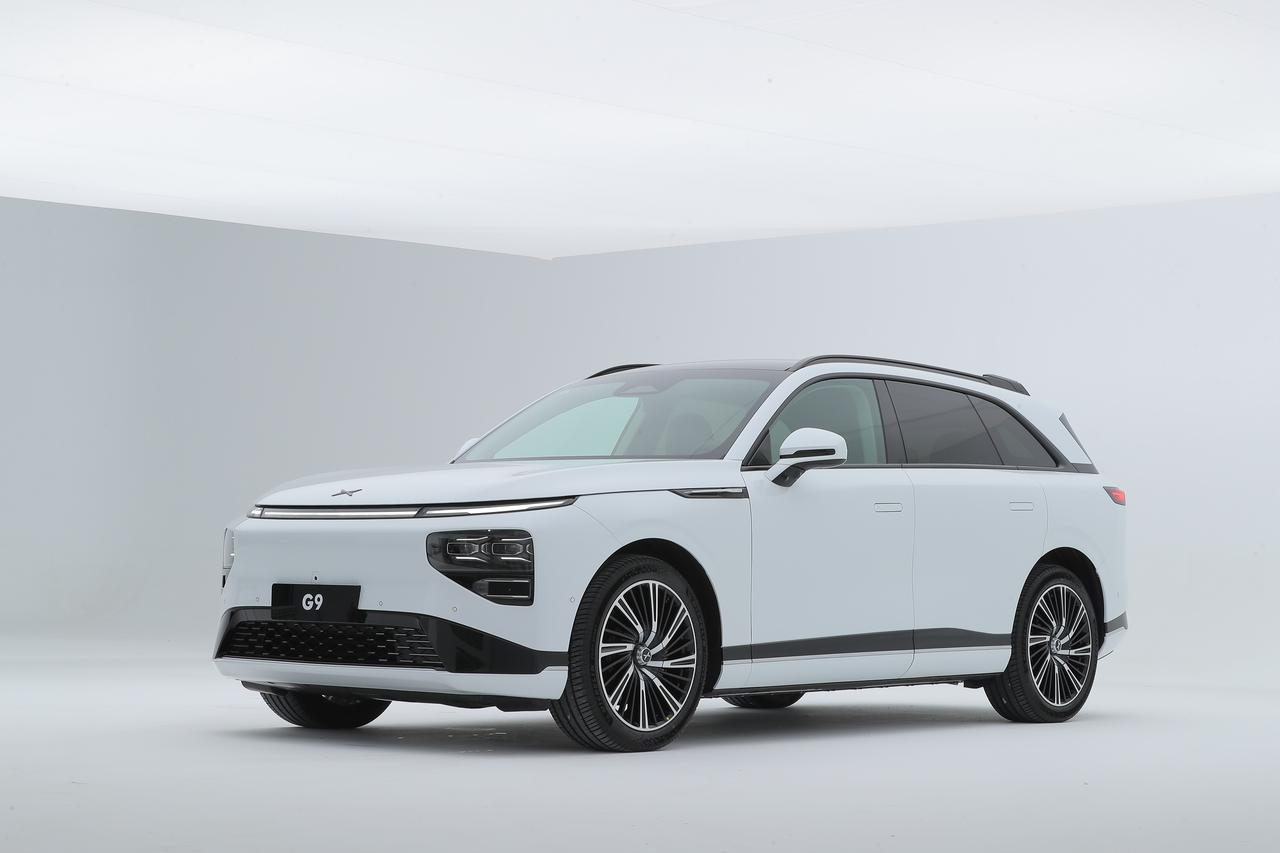
It has been half a year since XPeng G9 first appeared at the Guangzhou Auto Show and experienced the static display today. With competitors releasing their new flagship SUVs one after another, as a XPeng car owner, I am eager for G9 to arrive soon.
After experiencing G9 today, I indeed feel that XPeng is making a flagship car that surpasses its “7 series” with its heart and soul. Although the dynamic performance and pricing of G9 are still unknown, we cannot draw a final conclusion on G9, but I already see XPeng’s understanding of its own high-end road in G9.
Undeniably, with the release of AVATAR 11, XPeng G9 will face not only NIO and Ideal, but also new players following closely behind. When these new players present their products that have unique appearances and exquisite materials, the challenges that XPeng G9 faces will be unprecedented. Whether XPeng G9 can “unfold its wings and break through the encirclement” ultimately depends on the market’s answer after its launch.
This article is a translation by ChatGPT of a Chinese report from 42HOW. If you have any questions about it, please email bd@42how.com.
